
OFFICIAL PUBLICATION OF THE NORTHEAST DAIRY FOODS & SUPPLIERS ASSOCIATIONS


OFFICIAL PUBLICATION OF THE NORTHEAST DAIRY FOODS & SUPPLIERS ASSOCIATIONS
The Emphasis Will Be on Health and Wellness in 2024
LEGISLATIVE REPORT Nearing the End of the Session
SOMETHING TO CONSIDER Indianapolis 500 Winners Celebrate With Milk
ASSOCIATION NEWS Dairy Blender Recap and Other 2024 Events
SALES + MARKETING Data-Driven Decisions for PPC Success
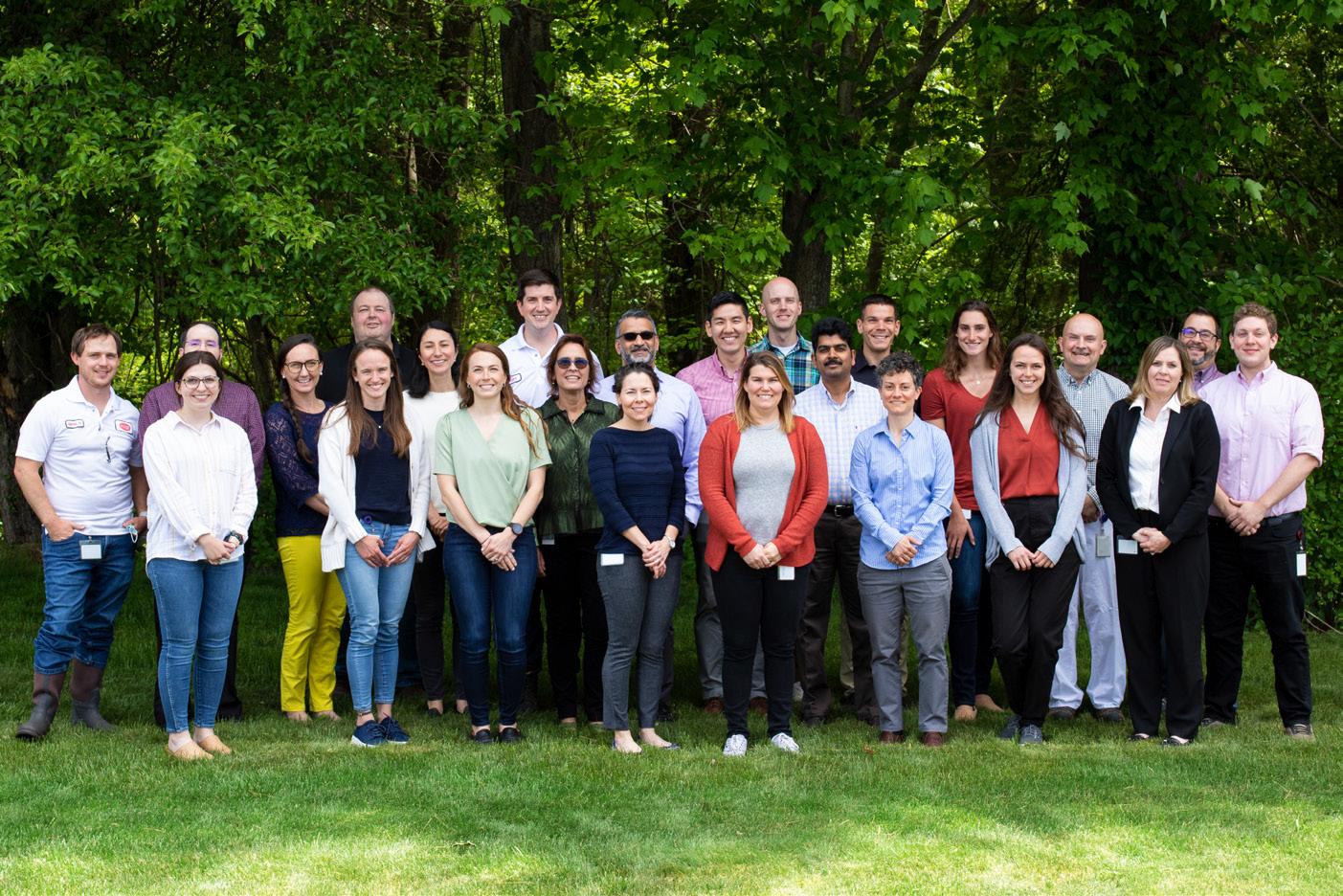












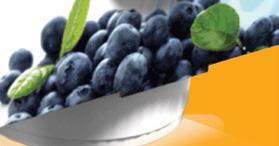

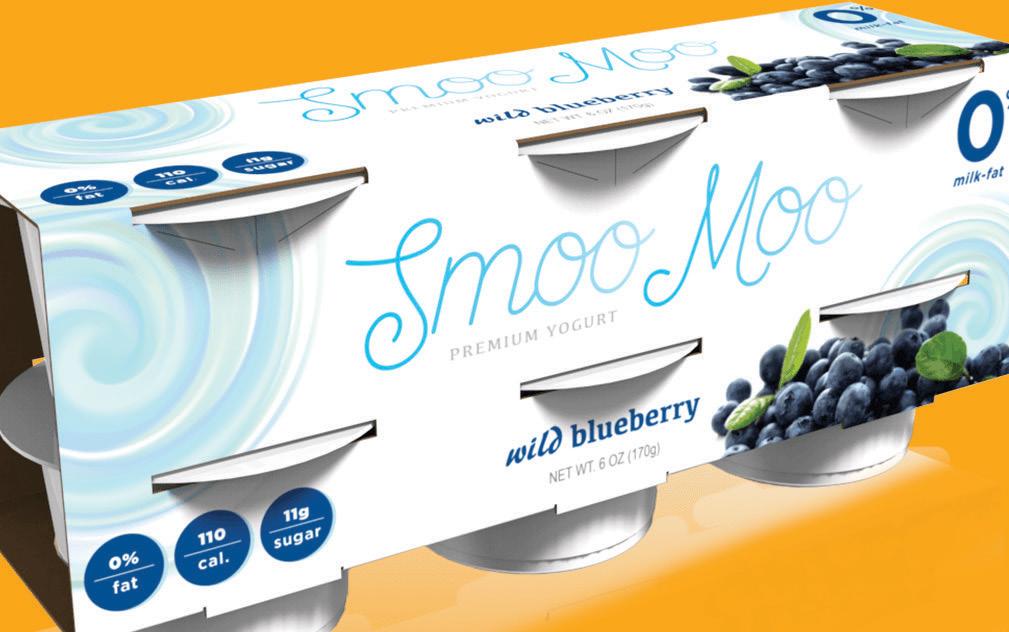















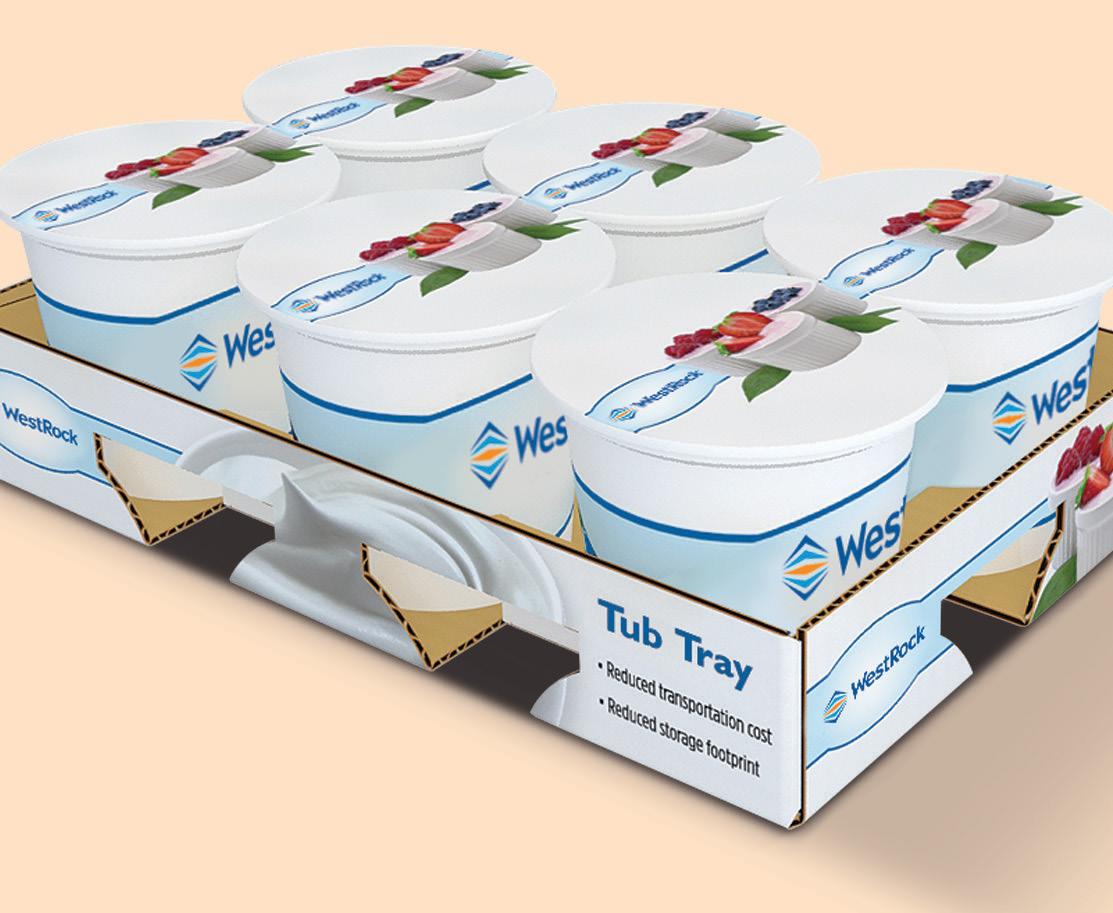

You need breakthrough pac kag ing on t he shel f. We have innovative solutions.

































We understand the challenges you f ace in the marketplace. From protecting your product as it travels, to making a strong first impression on the shelf, it ’s a tough journey. We leverage consumer insight with an ex tensive substrate port folio and printing knowledge to create custom packaging that gives you an unrivaled advantage. Learn more about our unique packaging options at ww w.westrock.com.
You + WestRock = Unrivaled Advantage
For further information, please contact: john.bucklin@westrock.com | 585-507-7298







EXECUTIVE DIRECTOR
Alex Walsh
BUSINESS OPERATIONS MANAGER
Leanne Ziemba
PRESIDENT
Daniel Lausch Lactalis USA – Commonwealth
VICE PRESIDENT
Jodi Smith Krzysiak Upstate Niagara Cooperative
TREASURER
Randi Muzumdar Lactalis American Group
SECRETARY
Ryan Elliott Byrne Dairy
PRESIDENT
Melissa Fryer Exergy, LLC
VICE PRESIDENT
Paul Knoerl Pactiv Evergreen
TREASURER
Ryan Osterhout KCO Resource Management
SECRETARY
Bruce Alling
Double H Plastics, Inc.
PUBLISHER
Bill Brod billbrod@nedairymedia.com
EDITOR
Courtney Kless courtneyk@nedairymedia.com
CONTENT DIRECTOR
Steve Guglielmo steveg@nedairymedia.com
RESEARCH & DEVELOPMENT COORDINATOR
Athena Cossette athena@nedairymedia.com
COPYWRITER
Nicole Smith
GRAPHIC DESIGNERS
Robin Barnes, Renate Wood
SALES
Tim Hudson thudson@nedairymedia.com
Lesli Mitchell lmitchell@nedairymedia.com
Hannah Gray hannahg@nedairymedia.com
CONTRIBUTORS
Brian Bluff
PRODUCED BY Northeast Dairy Media
Editorial correspondence should be directed to courtneyk@nedairymedia.com
Advertising correspondence and materials should be sent to lmitchell@nedairymedia.com









An official magazine of the Northeast Dairy Foods & Suppliers Associations, a nonprofit organization. This publication carries authoritative notices and articles in regard to the activities and interests of the associations. In all other respects, neither the association nor the producer of the publication, Northeast Dairy Media, is responsible for the contents thereof or the opinions of the contributors.
The entire contents are © 2024 by Northeast Dairy Media. Nothing may be reproduced in whole or in part without written permission of the publisher. The association and Northeast Dairy Media reserve the right to print portions or all of any correspondence mailed to the editors without liability on its part and no such correspondence will be returned.
Visit The Northeast Dairy Foods & Suppliers Associations online at ndfsa.org for current information on association programs and services, or call the association at 315-452-MILK (6455). Questions and comments may also be sent to the association at leanne.ziemba@ndfsa.org.

t is no secret that over the past several decades, milk consumption has been diminishing, with several studies demonstrating this. Without a doubt, over time, there has been an increase in the availability of alternative beverages. These alternatives are not all necessarily marketed as replacements for milk, nor are they dairy products at all.The growth of carbonated beverages (soda, flavored seltzers), sports drinks, energy drinks, and bottled water have impacted milk consumption as a primary beverage of choice in the past. Recently, there has also been a decrease in the purchase of some of these beverages, with no support for one category of beverage negatively affecting the purchase of another.
Sales of plant-based milk alternatives continue to increase as well. Newer beverage products may use certain terms and phrasing, combined with packaging, that highlight product attributes they feel may impact consumer choice. These can include certified organic, non-GMO, lactose-free, high-protein, and fat-free, just to name a few. This feeds the narrative that certain products are inherently healthier than others, including milk. Milk products have started to include, and should increase their use of, these nutritional terms to highlight the inherent product attributes that consumers are searching for, and that dairy products deliver.
One dairy product that is using this nutritional information to its benefit comes from the newest member of the NDFA, fairlife, with their line of ultrafiltered, high-protein products. The growth of this product line has led to the recent groundbreaking of a new $650 million, 745,000 square-foot facility in Webster, New York. This is certainly a welcome addition to the northeast dairy industry, and we look forward to working with this facility as it provides additional market growth in the region.
Another bright spot in the dairy sector is yogurt, where forecasts continue to point towards growth. Flavor varieties and taste are the primary drivers of consumer purchasing
decisions, with perceived health benefits, such as protein content or all-natural labeling, also playing a part. Continued investment in new and innovative flavors that meet consumer nutritional demands will help drive the growth of yogurt consumption. Similar to the milk sector, increased competition from non-dairy (plant-based) yogurt products will challenge the market. The dairy sector needs to remain engaged in monitoring consumer moods and purchasing trends. I still believe there is room for both products in the marketplace. Consumers who require a dairy substitute due to allergies or intolerances now have acceptable alternatives. I continue to advocate for providing consumers with scientifically and factually based information that highlights all the benefits of milk and dairy products.
After the very successful March Dairy Blender in Syracuse, we are now planning for the upcoming Bruce W. Krupke Memorial Golf Tournament & Clambake on July 10. I hope you all are making your plans to attend and are inviting your colleagues and customers for a day of networking and discussion centered around the important issues of our industry. I have been told in the past that this event is the best kept secret in the dairy industry; let’s not keep it a secret!
Shortly after the clambake, we will be hosting our annual Northeast Dairy Convention from Sept. 25–27 in historic Saratoga Springs, New York. A full agenda of speakers has been planned to provide some of the most up-to-date and timely information for the dairy industry. Details and registration for these events can be found on our website: ndfsa. org/events. The members of both associations have always been responsible for the success of our events, and on behalf of both boards, we thank you for your continued support and look forward to seeing you at the clambake and annual convention.
As always, if there are any questions or comments on these events, feel free to reach out to me or any board member. See you this summer!

rends in the dairy business happen slowly over time, so much so that in the course of just one year, they can be difficult to recognize.
It’s kind of like watching a glacier move right in front of you. One or two dairy farms in one county sell their cows and exit the business of milking cows, or one milk plant shuts down, but the dairy business continues to roll on. The reality sets in when the last farm sells their cows, and you know there will be no more dairy farms in that particular county in the future. After 10 or 20 years, you look back and realize just how many dairy farms are no longer milking cows and selling milk in a particular region.
An example on the milk processor side is back in 2000, when we had the last major Federal Order Reform and Consolidation down to 11 Federal Orders from approxi-
mately 42 Federal Orders. There were six fluid milk plants in and around the New York City metro area. Now, they have all closed down processing Class 1 fluid milk. People are still purchasing and drinking milk in New York City, but that container of milk is being processed outside of the metro area and trucked in as a scheduled delivery, directly to a grocery store, distribution center, or depot.
So, the trend is for the current active dairy farms in the United States to continue to milk more cows per farm, and the same trend is true for the major milk plants that process that milk at fewer and fewer active processing locations.
Consumer trends are another subject that could fill this quarterly magazine all by itself: the size of the container, flavors, additives, Extended Shelf Life (ESL), Ultra High Temperature (UHT), and then just how many different fruit flavors there can be in a variety of dairy products.
Enjoy the following articles and advertisements.



hat a year it has been already. You can just feel the excitement and positive energy running through the dairy industry, the association, the members, the directors, and the staff. The success that has been seen in the first five months of the year continues to build as we head into the second half of the year. The directors and staff of the association have been working diligently to ensure that members are seeing and feeling the value of being a part of this strong organization.
One of the exciting parts of being part of the association is attending our annual events. Back in March, the fourth annual Dairy Blender was held in Syracuse, New York. The Dairy Blender was born out of the situation we faced as a result of COVID. Prior to COVID, a processing or manufacturing facility would open up its doors to supplier members so they could see inside their operations and meet with key personnel. With the restrictions that came in 2020, and the increased security, the Dairy Blender started as a way for members to network with each other. Fast forward a few years later, and the event has really expanded to more than just a networking opportunity but a learning platform as well.
The structure morphed and now consists of processors and manufacturers giving presentations from top personnel about their company, including company history, products, future plans, and what they look for specifically from a supplier. Following the presentations, everyone was able to network with each other over beverages and food, where I know new connections were made and relationships were strengthened. A huge thank you to the presenters this year (Byrne Dairy, Chobani, Dairy Farmers of America, and Great Lakes Cheese), all of our sponsors, and those who attended to make this a huge success. Towards the end of the year or early next year, be on the lookout for details about next year’s dairy blender!
Right around the corner is the always-anticipated Bruce W. Krupke Memorial Golf Tournament & Clambake on July 10! If you’ve never been, then this is the year to come. This annual tradition, which has been going on for decades and is always the second Wednesday of July, is a packed day of networking and fun. The morning tees off at 8 a.m. sharp with the golf tournament and just shy of 200 golfers at Rogue’s Roost Golf Course in North Syracuse, New York. Then, starting at 1 p.m. at the Spinning Wheel Events Center, is the largest dairy industry networking event in the northeast, the Northeast Dairy Clambake! It’s an afternoon filled with lots of food, drinks, music, raffles, auctions, and, of course, meeting and seeing old and new friends. Last year, more than 900 tickets were sold, and it continues to prove to be a great place to introduce yourself to other members, meet your board of directors, bring your employees, or give back to your customers.
It’s not too often that you have a large collection of companies and people from all facets of the dairy industry in one place, where you can mix a relaxing environment with doing business at the same time. This year, in an effort to maintain and increase relationships, legislators, staff, and government officials can purchase tickets. Get your ticket orders in, and let’s see more than 1,000 people come through the gates this year!
Another event that the association has been working hard on is the Northeast Dairy Convention. This year, we will be at the Holiday Inn in Saratoga Springs, New York from Sept. 25–27. The convention is a tremendous opportunity for supplier, processor, and manufacturer members to gather for networking, business session components, and some fun as well. For suppliers, it’s a great event to have a booth and provide displays and information, to meet with members from across the membership and the industry, and to learn. Manufacturers and processors will value the business sessions
on topics facing the industry, as well as the networking and fun activities scheduled. Topics that will be presented this year include environmental sustainability, consumer trends, workplace safety, workforce development, and a panel discussion focused on legislation and dairy industry policies. As always, there will be networking opportunities with cocktail hours, a VIP networking event for suppliers who have a vendor table with processor and manufacturer members, a golf outing, and for those who don’t play golf, a walking tour of downtown Saratoga. It’s a truly remarkable location, and this year’s agenda will certainly make this a worthwhile event for all.
It's important to note that, new for the convention this year, the association is offering discounted rates on registration. The earlier you register, the more you save! Additionally,
if your company plans on having more than one person attend, discounts are offered for the more people you send. These events are the culmination of months of planning and hard work done by your association staff and board of directors that are geared to enhancing your membership experience with the Northeast Dairy Foods & Suppliers Associations.
The association has also welcomed many new members in the last few months, which exemplifies that the work we are doing on your behalf is not only effective but also very valuable. As the associations continue to grow, we remain the voice of our members in the halls of state capitols across the northeast, increasing and strengthening our relationships with legislators and policymakers as well, as we remain firm in representing the interests of the dairy industry.

Turn to pages 38-41 for a recap of this year’s Dairy Blender – plus some more information about the association’s other upcoming events.
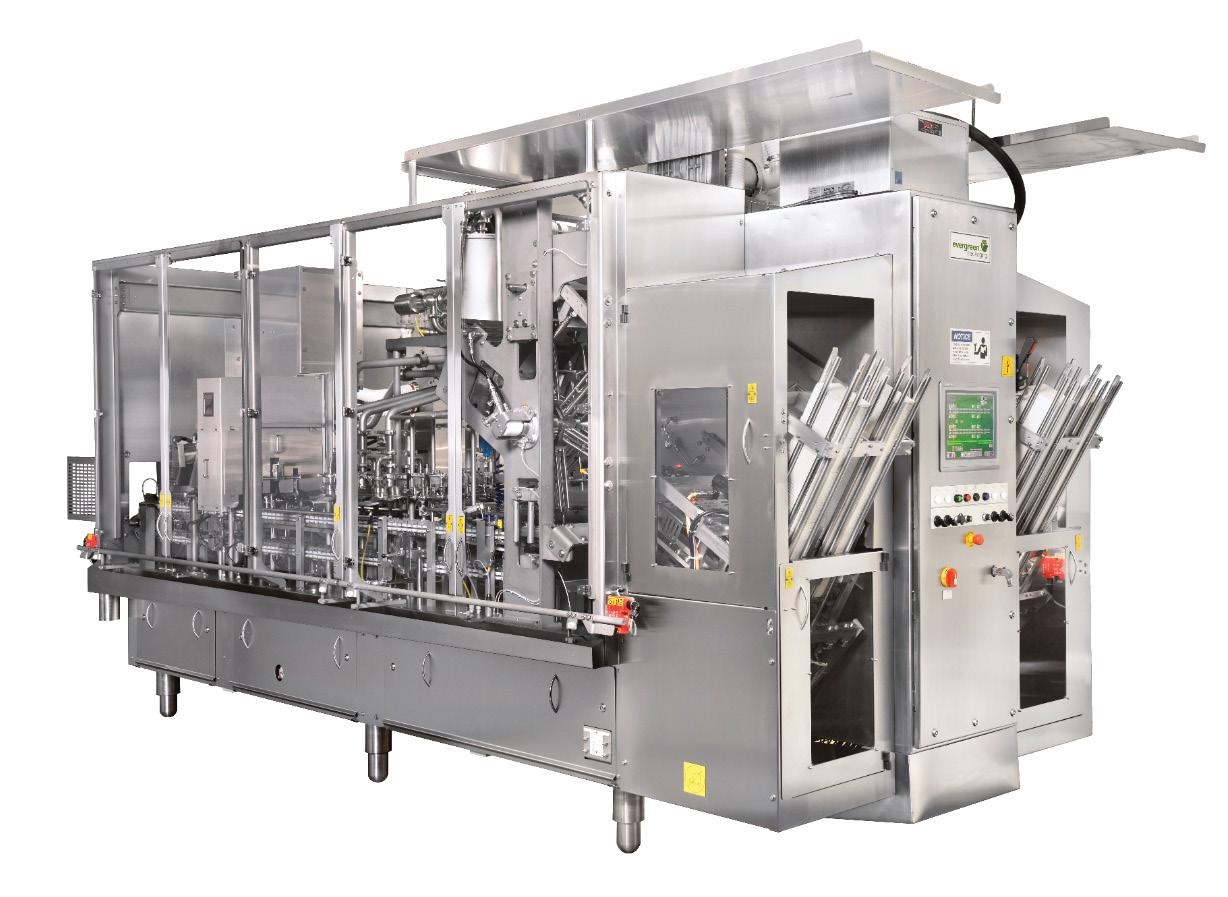
Improved performance • Easy access to machine components


For this issue, we asked board members from the Northeast Dairy Foods Association and the Northeast Dairy Suppliers Association the following questions:
1. Why is joining NDFSA important to your company when it comes to lobbying and government relations?
2. What other benefits do your company and employees receive from being a member and why are they important? (i.e. communications, networking events, company promotion, supplier opportunities and relationships, etc.)
This is what they said. And make sure to read the Q3 issue for our next “Ask Your Board” column!
Editor’s note: These answers were edited for clarity.
 John Bucklin, Business Unit Sales Manager, WestRock
John Bucklin, Business Unit Sales Manager, WestRock
1. Membership in the NDFSA allows WestRock to stay informed on legislative and regulatory issues impacting the dairy industry. Additionally, membership demonstrates our commitment to dairy and can help influence and shape our response to emerging issues such as sustainability.
2. At a local level, our individual box plants now have a ‘seat at the table’ in terms of gaining a deeper understanding of business issues affecting our important customers. The relationships we have formed have served us well over the years and provide a bridge to the next generation of WestRock employees who will serve our dairy customers.
 Ryan T. Elliott, Esq., Management, Byrne Dairy, Inc.
Ryan T. Elliott, Esq., Management, Byrne Dairy, Inc.
1. As a dairy processor in the northeast, we face a never-ending stream of challenges in the day-to-day operation of our business, which consumes a lot of mental real estate and resources. With various state and federal legislators drafting and passing legislative initiatives regularly, it’s a daunting task to have a full command of all the prospective legislative agendas that may directly or indirectly affect our business.
That’s where the NDFSA steps in. Its staff maintains a firm grasp on recent and relevant fields of legislation and policy proposals affecting our industry, and it channels this information to the membership in a timely manner, so that
we’re afforded an opportunity to coalesce our collective understanding, positioning, and response to such matters.
2. Fortunately, there’s no shortage of benefits when it comes to being a member of the NDFSA. During my time with the association, I’ve been pleasantly surprised to learn that each member assigns a different rank or value to the NDFSA’s various offerings, and I think this point speaks to the strength and depth of the association’s work on behalf of members.
On a more personal level, at Byrne, I believe our company extracts the most value from having greater access to trusted advice and counsel from industry leaders, as well as the opportunity to gain a deeper understanding of proposed legislation and current events affecting industry.
Finally, I know that all our team members look forward to the NDFSA’s networking events, most notably the annual clambake and golf outing, where they’re able to strengthen existing connections, and form new relationships, with other dairy professionals.

1. Networking and dairy industry connections at a personal level, not doing business through a computer.
2. Newer employees get to see a wider scope of our dairy industry that can provide long-term employment for as many years as you want to in the business.

1. The updated information sharing is critical for staying informed of the latest issues. Having that support function to the organization provides some peace of mind knowing they are trying to move the dairy industry in the right direction.
“Fortunately, there’s no shortage of benefits when it comes to being a member of the NDFSA.”
2. The NDFSA provides numerous opportunities for our employees. We take advantage of networking events such as the Dairy Blender and clambake; communications and continuing education through the annual fall meeting; and the chance to source necessary parts and services by exposing additional vendors and suppliers through their annual directory and buyers guide and other networking channels.
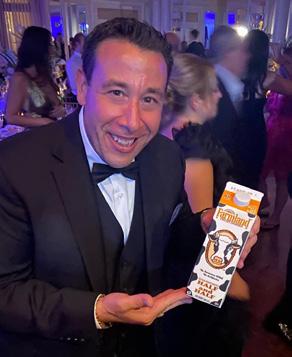
1. Our company benefits from learning about regulations and bills that the dairy industry must adhere to in order to forecast the future of our business.
2. We enjoy the networking opportunities as well as the relationships with our peers to grow our dairy distribution successfully. By participating in this organization, we can learn firsthand about future trends in the dairy industry.

Networking events and relationships are the primary reasons for our involvement and support of northeast dairy. This is a people industry – customers, producers, and suppliers all together.

The month of June is a wild one. The month is designated as National Dairy Month, where we celebrate and recognize the importance and significance of the entire industry, from the cow and producer, the processors and manufacturers, retailers, and consumers and the impact we have on millions across the globe. At the same time, most state legislatures in the northeast are wrapping up their legislative sessions for the year. That means there is this mad rush to tackle any outstanding bills and issues, vote on legislation, and get them delivered to governors for their signatures before lawmakers adjourn for essentially the remainder of the year.

Hopefully, with the restrictions in place, increased testing, and other precautionary measures, the issue can be controlled and resolved soon. If you have any questions or would like any additional information regarding state-specific restrictions or orders placed by the United States Department of Agriculture, please contact the association and we will provide you with the answers you are seeking.
A large issue impacting the dairy industry across the country in the last few weeks has been Highly Pathogenic Avian Influenza (HPAI). New York as well as other states are taking precautionary measures in order to control the spread. New York State, for example, issued temporary import requirements for dairy cattle. Some of these requirements include:
1. The importation of dairy cattle from premises with a confirmed case of HPAI or a premises under investigation as a suspect premises is prohibited.
2. Dairy cattle imported from affected states must be accompanied by a Certificate of Veterinary Inspection (CVI) issued within 10 days prior to entry into the state.
3. CVIs issued for dairy cattle from affected states must include the statement: “All animals identified on the Certificate of Veterinary (CVI) have been examined and do not originate from a premises with a confirmed detection of Highly Pathogenic Avian Influenza, or that is currently under investigation as a suspect premises.”
4. These requirements will remain in place until further notice.
Continuing on with some updates at the federal level, processor members who produce milk for school should be aware that in late April, the USDA released its final rule updating the meal patterns for the National School Lunch Program (NSLP) and the School Breakfast Program (SBP). The updated rule delivered significant wins for not only the dairy industry, but for child nutrition as well.
The final rule preserves the ability for schools across the country to serve nutritious flavored milk to students in all grades, which ensures an 8-ounce half-pint of non-fat or low-fat flavored milk that contains no more than 10 grams of added sugar per serving. Additionally, the rule re-emphasizes lactose-free milk as an option in all reimbursable meals. Offering lactose-free milk as a choice to all students will mark major progress for child health and nutrition equity in school meals. The rule maintains current school meal sodium targets through the 2026–27 school year before adopting a more attainable, and permanent, school meal sodium target, thereby preserving cheese as a healthy part of any meal. The Northeast Dairy Foods & Suppliers Associations worked closely and collaborated with members and industry partners, including the IDFA, on this issue.
Additionally, changes to the Federal Order system are still being worked on, and more are expected to come out in the coming months, as well as the Farm Bill.
“The association remains steadfast at monitoring issues and any bills that may sneak in and continuing our relationships with legislators so that they immediately know who to turn to when an issue that impacts the dairy, food and beverage, or agriculture sectors comes up.”
Also in April, albeit late and past the deadline, New York State passed its budget. Some key takeaways from the passage of the New York State Executive Budget in regard to dairy and agriculture include:
1. The New York State Dairy Farm Modernization Grant Program, which is administered by Farm and Food Growth Fund, Inc., received $24 million. With this funding, grants will be available to farms and agricultural marketing cooperatives to be used to help expand on-farm milk storage capacity, improve efficiencies, invest in milk transfer systems, cooling technologies, and other opportunities for producers to transport or store their products. This funding was a high-priority push for the association to be funded.
2. More than $54 million for the Nourish NY Program, the highest funding level the program has ever seen.
3. Important agricultural education and outreach programs saw restorations and funding increases across important programs such as FFA, Cornell Cooperative Extension, Pro-Dairy, and Pro-Livestock. Additionally, funding was included for the Cornell Farm Labor Specialist and the Cornell Small Farms Program, which assist farmers with labor laws and regulations and provide other management support services and training. These are critical programs that the association advocated for to ensure they received funding.
4. Labor laws: COVID-19 Sick Leave will sunset as of July 31, 2025.
Also starting to gain more traction in New York is the debate about Extended Producer Responsibility (EPR), A5322B/S4246B, despite opposition or at least serious concerns from many organizations. The concept has been floating around the halls of the Capitol for several years and has been increasing as other states, such as California, have passed similar laws. The association has been voicing concerns received from members about EPR to legislators,
knowing that this regulation is eventually going to be a reality, and trying to make the program workable and feasible for the industry.
In Maine, a farmworker minimum wage increase was introduced. In communication and collaboration with members in Maine as well as industry partners, the association took a position that we value a strong workforce and recognize that most dairy farmers are already paying the minimum wage or better, so codifying it in law is not necessary. This bill was ultimately vetoed by the governor.
In New Hampshire, the state is looking to create a twoyear pilot program to reimburse 10 public schools that purchase food from New Hampshire farms. The program would cover purchases of dairy, fish, pork, beef, poultry, eggs, fruits, vegetables, cider, and maple syrup, and would allow schools to buy from food hubs, distributors, or directly from farms. Under the proposed program, schools would be reimbursed for 33% of what they spent. These programs are avenues for increasing the number of dairy products purchased in schools and consumed by students.
Food additive bills (directed at eliminating certain additives in the manufacturing of food and other products) have been introduced in several states, including New York. The notable concern here is the titanium dioxide that is on the list, which is used in cheese, creamers, and other products. While amendments have been made to the draft legislation in New York, the goal is to remove titanium dioxide from the list.
Other bills the association continues to monitor and engage on include expansion of raw milk sales, packaging and labeling changes, labor regulations, and many more that have an impact on the membership and your ability to conduct business.
However, while legislatures are on the eve of being recessed, that does not mean that bills can’t be introduced, issues won’t arise, or special sessions won’t be called in to handle matters. The association remains steadfast at monitoring issues and any bills that may sneak in, and continuing our relationships with legislators so that they immediately know who to turn to when an issue that impacts the dairy, food and beverage, or agriculture sectors comes up.


Alex Walsh is the executive director of the Northeast Dairy Foods & Suppliers Associations. You can contact him by email at alex.walsh@ndfsa.org.
On May 15, we witnessed a record close on the Dow Jones Industrial Average (DOW) following a new report showing inflation easing a bit. A new Dow Jones record was set with a close of 39,908.00, up nearly 350 points on the news. Consumer prices in April were 3.4% higher compared to a year ago. The pace of inflation has slowed a bit since April. Housing and gasoline prices are higher, but the so-called “core” prices are showing the smallest increase in three years. Investors cheered the news with hopes of a Fed rate cut.
The U.S. Bureau of Labor Statistics defines the Consumer Price Index (CPI) as a measure of the average change over time in the prices paid by urban consumers for a representative basket of consumer goods and services. The CPI measures inflation as experienced by consumers in their day-to-day living expenses and is used as a measure of inflation, closely followed by policymakers, financial markets, businesses, and consumers.
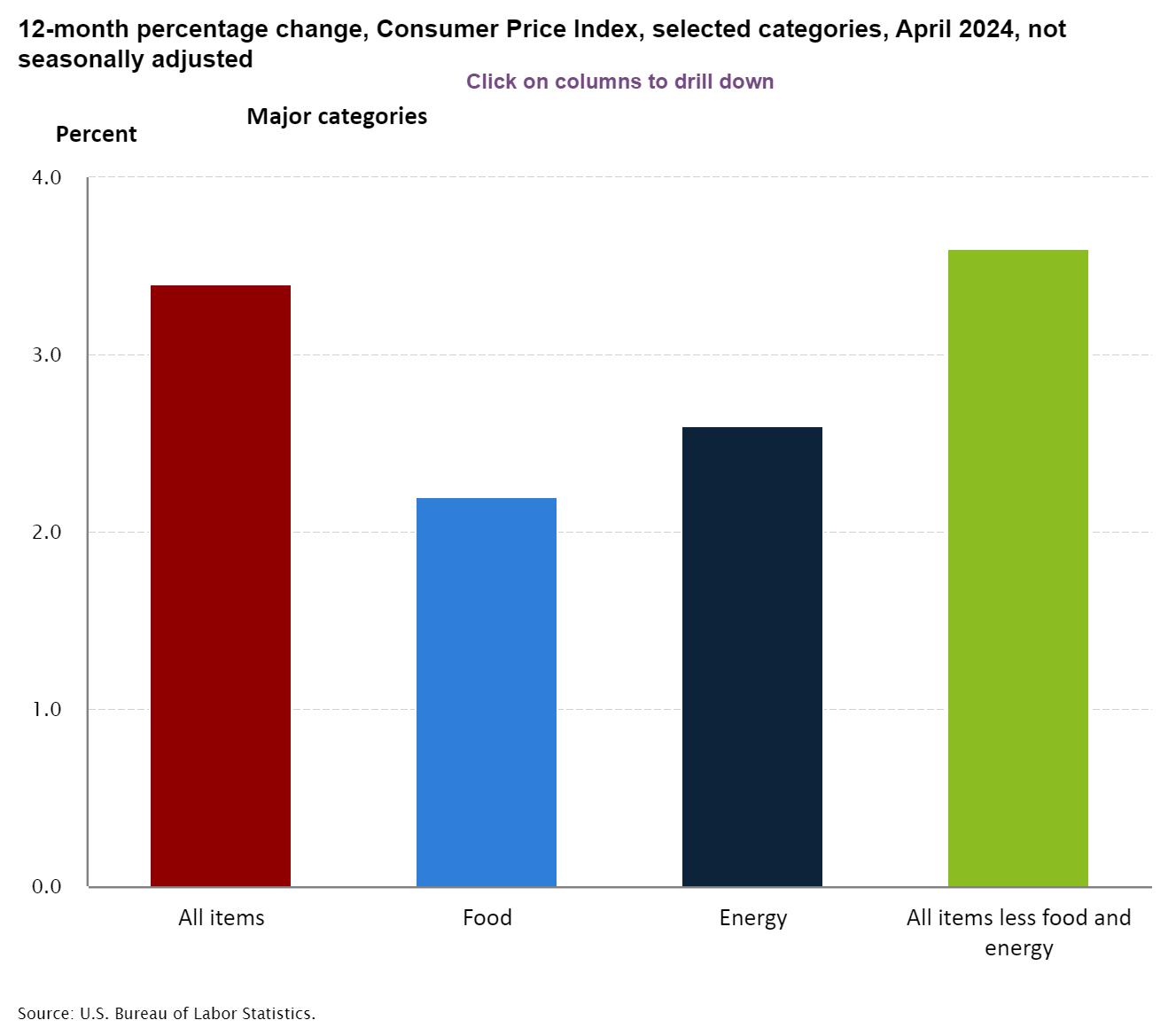
Breaking out the at-home food section shows six major categories, with dairy being the only one down in price at -1.3%. Cereals and bakery products are +0.6%; meat, poultry, fish, and eggs are +1.0%; fruits and vegetables are +1.7%; beverages are +2.3%; and other food is +1.4%.

While the inflation rate is still well above the Fed target of 2%, the May announcement reignites hopes that there could be an interest rate cut later this year. Also, other new data shows retail sales were flat in April, which was unexpected but welcome news.
Table A below shows recent month-to-month changes in the CPI. The prices of automobiles, food, and other goods have pretty much stopped rising. Food inflation has been near zero for the last few months, while auto insurance and rent prices are still climbing. In recent weeks, gas and diesel prices have moved down a bit but could rise with summer approaching.


The new 3.4% inflation rate is a large decline from the peak of 9.1% in June 2022, yet still above the 2% target. News from across the states repeatedly indicates that consumers are worried about prices. Food prices are at the top of consumers’ minds and are already playing a role in shaping presidential politics. Inflation overall has jumped 19% over the last four years, but grocery prices have risen nearly 25% during the same period.
High grocery prices are taking up a large chunk of consumers’ dollars. A survey by Yahoo Finance/Ipsos late last year revealed that over two-thirds of the respondents’ said inflation was hitting them the most severely with higher food costs. According to the news release, “Regardless of political affiliation, a strong majority of registered voters say inflation over the last two years has been unusually high (88%). Inflated prices are widely affecting food prices, as over two-thirds of voters (67%) say this is the area they have seen most impacted by inflation.”
The frequency with which consumers shop for groceries and essentials keeps higher prices front and center, as opposed to quarterly and monthly bills like insurance. Most consumers make visits to food stores weekly or several times a week, so awareness of higher grocery bills is heightened. Lower-income families can spend more than 30% of their income on food, while wealthier families spend 8-10%.
High food costs are a combination of rising wages at farms, transport, processing plants, warehouses, grocery stores, restaurants, energy, supply chain disruptions, political conflicts, and a plethora of other factors. Retail food inflation is not uniform across the U.S. but varies by location.
On April 1, a new California state law took effect, raising the minimum wage from $16 an hour to $20 an hour. In one fell swoop, labor expenses hiked 25% and will be passed
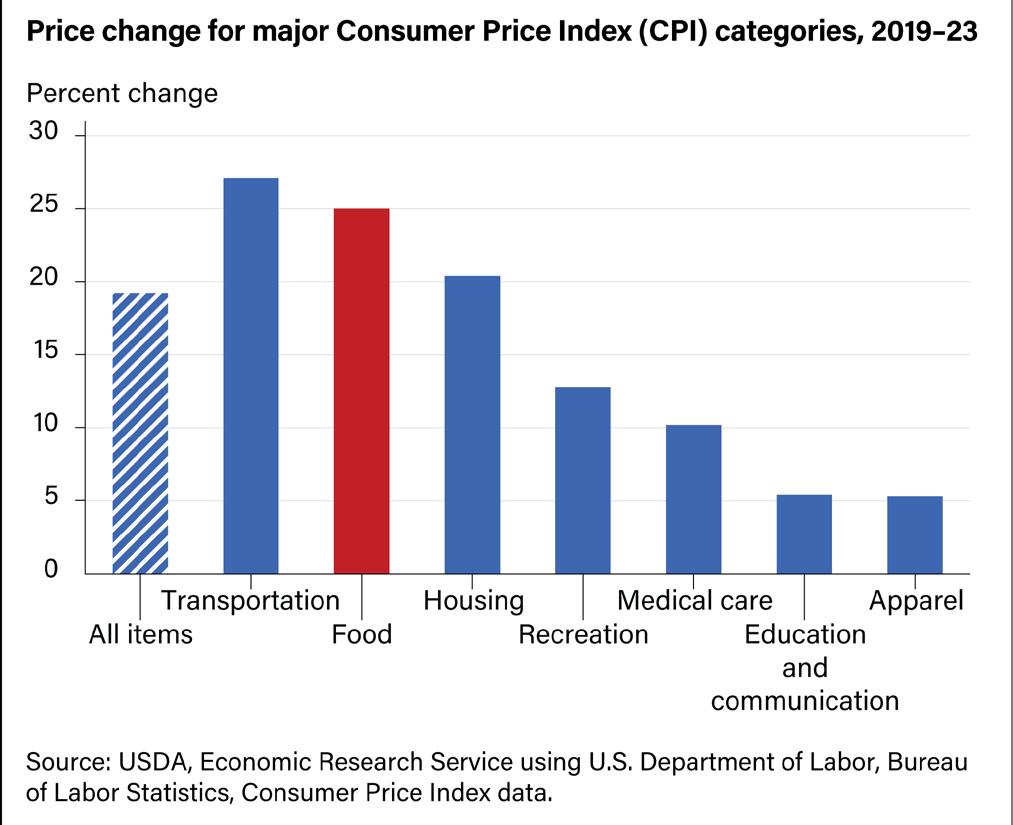

along in the cost of goods sold. Businesses are faced with passing along more price increases, cutting back on employee hours, or layoffs. The fast-food industry has been exploring the use of new technology to help with the problem. Chipotle is experimenting with a prototype robot called the Autocado that can peel and cut avocados. McDonald’s is experimenting with digital kiosks since customers are getting used to placing digital orders. McDonald’s has been accused of being less attractive to lower-income consumers with its Big Mac and fries than it once was. Last year, McDonald’s raised prices by 10%, and by 100% or more since 2014, according to a study by FinanceBuzz. Similar situations exist with KFC, Taco Bell, Pizza Hut, and others.
Dairy products have been hit hard by inflation at the grocery stores. As shoppers become more discriminating with their money, private labels have gained more prominence. According to Dairy Foods, cheese has surpassed fluid milk as the number 1 private-label dairy category.
“Private label is outpacing brands in 10 of 15 dairy categories. Private label is making strong inroads in yogurt, cream cheese, cream/creamers and margarine/spreads, and continues to be a strong player in refrigerated whipped toppings,” said John Crawford, vice president, Client Insights-Dairy, for Circana, in an interview with Dairy Foods. “Cottage cheese is seeing strong growth for both brands and private label as TikTok lifted the entire category.”
Consumer high food cost pain has evolved into one of many campaign topics mentioned by President Joe Biden, Robert F. Kennedy Jr., and Donald Trump. The candidates have weaponized high food costs, using it to take shots at each other. Biden has backed off some from his frequent use of the term “Bidenomics,” according to the New York Post Kennedy, the Independent presidential candidate, found this food inflation fight too hard to resist and jumped into the fray. In a post on X, he wrote “I understand the pain Americans are suffering from high prices. Since he took the oath of office three years ago…
Butter is up from $3.58 to $4.75
12 Eggs up from $2.36 to $3.54
Milk up from $2.73 to $3.25
Peanut butter up $3.48 to $4.52
Toilet paper up from $7.08 to $9.75.
President Biden should be telling Americans that their anger is right and justified.”
Not to be outdone, the Super PAC for Trump created “Biden-Mart,” a website where visitors can see the difference between the cost of groceries during Biden’s and Trump’s tenures.
President Biden and his White House Council of Economic Advisors have pointed out that his administration has been of benefit in bringing fertilizer prices down and pushed an agenda to increase competition in agriculture. The Biden administration feels reduced costs being paid by producers should eventually be reflected in grocery stores and alleviate consumer pain. Biden often accuses large food manufacturers and grocery chains of using inflated prices to enhance their bottom lines.
On the other hand, some people believe former President Trump’s policies could make food prices even higher than they are now. Trump has been campaigning with the promise to initiate new tariffs on imports and vast deportations of undocumented immigrants. Such action is likely to raise costs in the produce, meat, and dairy industries.
The May release of USDA’s Livestock, Dairy, and Poultry Outlook provided an Update on Highly Pathogenic Avian Influenza (HPAI) Detections in Dairy Herds, writing: “As of May 14, Highly Pathogenic Avian Influenza (HPAI) had been confirmed in 9 States and 46 dairy herds. Starting with April 24, mandatory testing for lactating dairy cattle is required prior to interstate movement. Additional guidelines were issued by USDA, Animal and Plant Health Inspection Service (APHIS) on May 8. USDA has found that the virus can spread in several ways: within the same dairy herd, when dairy cattle change location, and from dairy to poultry. In some cases, dairy cows tested positive without showing any symptoms. The affected cows recovered within several weeks.”

The report continued, “The pasteurization process has continually proven to inactivate bacteria and viruses and hence reduce the risks to human health. Moreover, the U.S. Food and Drug Administration continues to advise against the consumption of raw milk.”
Additional reading:
• Highly Pathogenic Avian Influenza (HPAI) Detections in Livestock
• Questions and Answers Regarding Milk Safety During Highly Pathogenic Avian Influenza (HPAI) Outbreaks
• CDC A(H5N1) Bird Flu Response Update May 17, 2024
Rabobank reported in May that it has not seen any significant change in milk production or demand connected to the outbreak of bird flu. Impacts, if any, have been moderate so far.
On May 17, House Agriculture Committee Chair Glenn Thompson (R-PA) released a proposed five-year farm bill, which he called a “draft text.” The draft adopted some policy ideas from Democrats but still sets up what are likely to be clashes on conservation and nutrition programs. The bill has become a centerpiece for Democrats and environmental groups pursuing farming practices that reduce emissions tied to climate change. The bill is projected to cost $1.5 trillion over the next decade.
The draft enhances vital farm safety net program funding to support farmers and doubles trade promotion funding to develop and support new markets for exports abroad. It boosts specialty crop program funding and improves access to programs that lower energy costs for farms and small businesses.
While the early draft is set for debate in the coming weeks, some say the proposed cuts to the Supplemental Nutrition Assistance Program (SNAP) are opposed by Democrats and hunger groups. The draft text proposes to revoke nearly $14.4 billion designated for climate-friendly agricultural practices, which will likely draw much debate in the coming weeks.
The USDA finalized its changes to the Women, Infants, and Children (WIC) program with more than $7 billion in funding, up by $1 billion from last year. Both the IDFA and NMPF expressed disappointment with the new guidelines that reduced the amount of milk allowed per family. Although the new guidelines do expand the availability of other dairy products, Stacy Dean, Deputy Under Secretary for the USDA Food, Nutrition, and Consumer Services, tried to put a posi-
tive spin on it. “We actually predict that the amount of money that we’re spending on food, milk and dairy will continue to rise because even though the dairy package is slightly smaller, we will be serving more eligible people,” Dean said in an interview with Spectrum News 1
The Federal Milk Marketing Order hearing, held between August 23, 2023, and January 30, 2024, in Carmel, Indiana, has concluded. There were 40 proposals submitted, and the USDA agreed to hear 21 of them. Final formal legal briefs were submitted to the USDA on April 1. Now, the USDA has 90 days to review and issue a recommended decision, which will be no later than June 30. Then, 60 days later, a final decision will be issued, and the USDA will hold a referendum to allow the producers to approve or reject the proposed changes by vote.
• National Federal Milk Marketing Order Pricing Formula Hearing
• Federal Milk Marketing Order Program: Understanding the Milk Order Amendment Process
The dairy trade dispute between the U.S. and Canada was never satisfactorily resolved. U.S. dairy alleges that Canada fails to comply with the terms of the U.S., Mexico, and Canada Agreement (USMCA) for more open and free dairy trade. The heart of the dispute is about the Canadian allocation of import credits known as tariff rate quotas (TRQs). In 2022, the U.S. challenged Canada and won. Then Canadians made a few minor, insignificant changes. Then the U.S. challenged again in 2023 and lost. New Zealand filed its own complaint against Canada for similar reasons of violating the Comprehensive and Progressive Agreement for Trans-Pacific

Partnership (CPTPP) rules.
The U.S. Dairy Export Council (USDEC) believes 2024 will turn out to be a good year. Not as good as the dairy export record in 2022, and not likely as good as the next best record that was set last year. The global market is tough in 2024, but the U.S. is doing well, especially with cheese exports to Mexico and Latin America. According to USDEC president and CEO Krysta Harden, they are actively seeking relations with the continent of Africa. With 54 countries, Africa has a growing middle-class society. Parts of Africa are exporters of oil, gas, and diamonds. Other significant importers of U.S. dairy are South Korea, Japan, Oceania, the Middle East, and Southeast Asia. U.S. cheese exports have been excellent lately, but not so good for butter and other products.
The U.S. has a global price advantage with cheese, but not so with other products. We still sell a considerable quantity of various products with our trading partners, but not like cheese. Mexico is our best cheese customer, and they are close by.


For nearly a year, the number of cows in the U.S. had been trending down, and along with it was milk production. In the past few months, we have seen the addition of more cows and milk production showing small signs of trending up again.
The USDA also notes that margins have improved, writing, “In March 2024, dairy farmers’ milk-to-feed margins improved compared to March 2023 due to noticeably lower feed costs.” Corn, alfalfa hay, and soybean meal prices were
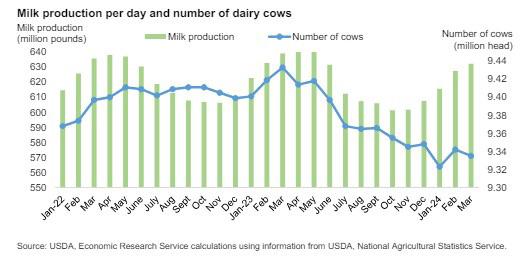

all reported down in the May USDA Livestock, Dairy, and Poultry Outlook.
The latest price forecast from the USDA has them raising both the cheese and butter prices from last month’s estimate. The USDA feels domestic demand will remain brisk for both items, and cheese exports will continue to be strong due to our price advantage globally. On the flip side, the USDA is expecting weaker domestic and export sales for nonfat dry milk and dry whey. Hence, expected sales of both items were reduced in the USDA's latest forecast.
The forecast for the average Class III price was raised. The higher cheese price more than offsets the new lower forecast for dry whey. The average Class IV forecast was lowered from last month. The strength of the butter price is not enough to offset the lower nonfat dry milk estimate. So, the USDA’s updated May revisions have the 2024 Class III milk price projected at $16.75 (+$0.55) per hundredweight (cwt), while the Class IV milk price is projected at $20.25 (- $0.15) per cwt. The 2024 all-milk price forecast is projected at $21.20 per cwt, $0.30 per cwt higher than the previous forecast.
Additional reading:
• Northeast Region Food Price Index– April 2024
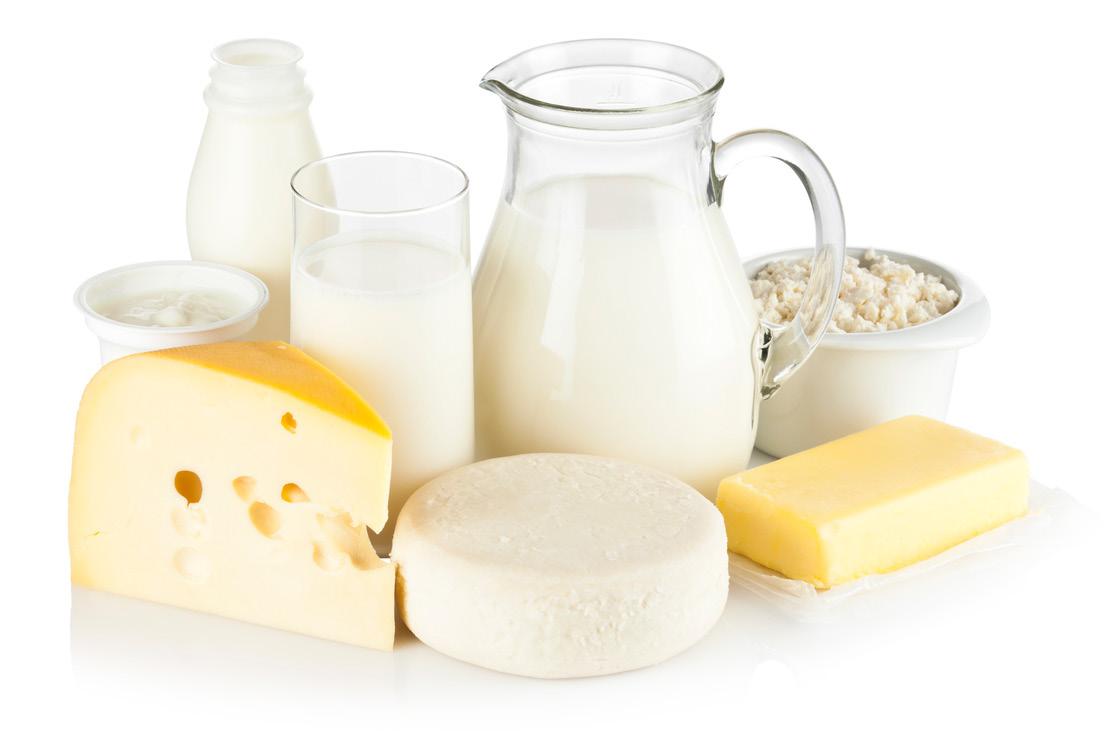
Area prices were up 0.4% over the past month, up 3.6% from a year ago. The dairy and related products index was the only grocery category to decline, down 1.0% from last April as it declined for the fifth consecutive month.


Gary Latta is a dairy product specialist consultant for the Northeast Dairy Foods Association, Inc. He has more than 30 years of experience in providing economic analysis, statistics, and information to the dairy processing industry.






The Indianapolis 500 is held each year at the end of May. A high point takes place at the conclusion of the race when the winner drinks milk.
In recent years, winning drivers not only drink milk from quart-size glass bottles but also douse themselves in dramatic fashion. Fans and photographers enjoy this moment in victory lane, capturing it on film.
So how did this practice get started? The first driver credited with drinking milk at the Indianapolis 500 was Louis Meyer. Meyer was the event’s first three-time winner, taking the prize in 1928, 1933, and 1936. It was the 1936 victory where history records the first drinking of milk, which was buttermilk.
Legend has it that as a young boy in Yonkers, New York, Meyer’s mother convinced him that drinking buttermilk would be refreshing after physical activities on a hot day. This was advice that Meyer carried with him throughout his life and racing career.
Meyer claimed that he drank cold buttermilk following his win in 1933, and likely he did, but there are no photographs or news reports to support it. However, drinking cold buttermilk from a glass bottle following his win in 1936 is officially the start of the tradition, documented with photographs and film.
Meyer drove his No. 8 race car to the victory circle and sat on the back when someone handed him a bottle of but-
termilk (you can watch it here). The event announcer then said, “Someone has given him a bottle of milk. Well, that race would make anybody thirsty.” Legend has it that an opportunistic marketing person from the dairy industry witnessed the celebratory act and encouraged the Indianapolis 500 promoters to offer future winners a bottle of milk.
The idea caught on, and for a few years, milk was seen being chugged in victory lane after each race. Annual racing was put on hold during WWII. Following the war years, racing was resumed, and so was the tradition of drinking milk. By this time, buttermilk was dropped in favor of regular milk, and then water was offered in silver cups for a few years. In 1954, milk celebrations resumed and have been part of the Indianapolis 500 tradition ever since.
In 1954, the Indiana American Dairy Industry Association offered $400 to the winning driver and $50 to his chief mechanic to pose drinking milk from a glass bottle. Today, those amounts have increased to $10,000 and $1,000, respectively.
Before each race, every driver is polled to determine which type of milk they prefer if they win. The options are whole, 2%, and skim. Each bottle is stored in the track fridge until the winner is announced. Two preselected dairy farmers representing the American Dairy Association of Indiana present the cold milk to the race winner in victory lane. One

dairy farmer is designated “the official” and hands the bottle of milk to the driver. The second dairy farmer is designated as “the rookie,” considered to be in-training, and hands bottles of milk to the winning chief mechanic and team owner. Next




year, “the rookie” will move up to “the official” role, and a new rookie will be selected.
For 2024, the race milk bottle official presenter is Alex Neuenschwander, a fourth-generation Indiana dairy producer, and the rookie presenter is Abbie Herr from Herr Dairy.
“The Indy 500 is all about tradition and I’m excited to be part of the tradition,” Neuenschwander said in an interview with Hoosier Ag Today. “It is such a huge stage for all of the hard-working men and women that are in the industry. I’m excited and humbled to be part of that and to be chosen and by my fellow dairy farmers is a huge honor.”


Gary Latta is a dairy product specialist consultant for the Northeast Dairy Foods Association, Inc. He has more than 30 years of experience in providing economic analysis, statistics, and information to the dairy processing industry.







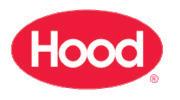

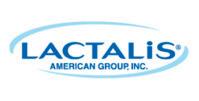

Each year for the Q2 issue, Northeast Dairy Magazine talks to Donna Berry (who covers new products and trends for the dairy industry) about what we can expect in the coming year.
In 2024, she believes the emphasis will continue to be on protein and immunity.
“One of the biggest motivators right now in food and beverage is health and wellness and food as medicine,” Berry added. “Consumers are hearing this and they’re reading up on it. They’re recognizing that you are what you eat.”
There has also been some pushback on ultra processed foods.
“While some might characterize dairy as being ultra processed, the reality is that compared to other stuff, it’s minimally processed,” said Berry. “So, it’s a really good position for dairy to be in.”
Read on for some of the trends she is seeing in each segment.
One space where health and wellness aren’t dominating is ice cream.
“Those high protein, low sugar products didn’t have longevity,” said Berry. “Ever since COVID, consumers believe it’s ok to enjoy food and take a little break and have something indulgent. As a result of that, just true, delicious, ‘how much stuff can you put into my ice cream and make it good’ is what is dominating right now.”
As are nostalgic flavors, like cotton candy and butterscotch.

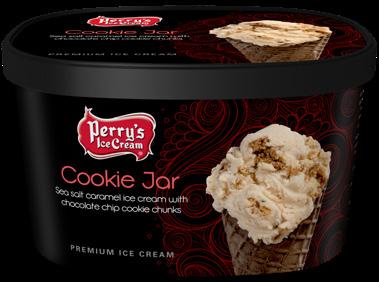
Perry’s Ice Cream has a few new additions to its lineup – and they may feel a little familiar.
The company said the five flavors (Caramel Panda Paws®, Over the Moon, Bee Sting, Fruit Scoops, and Cookie Jar) were inspired by current trends in the space.
“With consumers feeling nostalgic and reminiscent, we focused our flavor development on classic flavors that offer a twist of something new while invoking joyful memories,” said Megan Mergler, associate product manager, in a press release.
“A lot of those are gearing towards being non-chocolate, because there is a major cocoa bean shortage that does not show any signs of letting up,” said Berry. “Ice cream is clearly one of the categories that has flexibility; you don’t need to have an ice cream that has chocolate in it.”
Berry is seeing a lot of activity in this space with high protein and specialty products.
“Milk that is value-added is doing very well,” she said.
One recent innovation is Organic Valley’s Family First™ line, whole and 2% milks with DHA Omega 3 added.
The lactose-free claim is also “very big” right now. In April alone, two processors (Prairie Farms and Hiland Farms), unveiled gallon options for consumers.
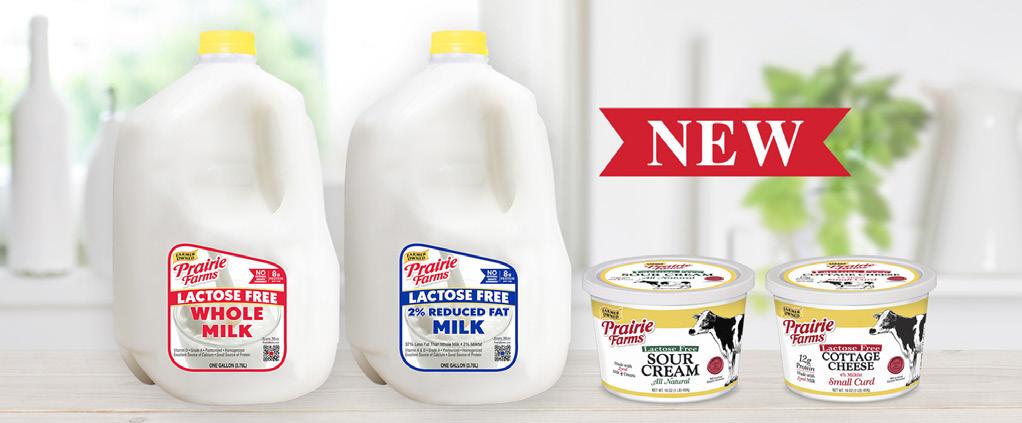
“One of the biggest motivators right now in food and beverage is health and wellness and food as medicine. Consumers are hearing this and they’re reading up on it. They’re recognizing that you are what you eat.”
–Donna Berry
Keeping in line with the idea of indulgence and the shift away from viewing fat as unhealthy, products made with whole milk are performing better among consumers than those that are low or nonfat.
“Plain old cottage cheese is really booming right now,” said Berry. “The focus is on protein. It is the same thing with yogurt. Greek yogurt has become part of the mix. But some of the more indulgent flavors are also doing quite well.”
When it comes to cream cheese (and sour cream), “customers are looking for minimal processing, which also correlates to fewer ingredients and cleaner labels,” said Berry.

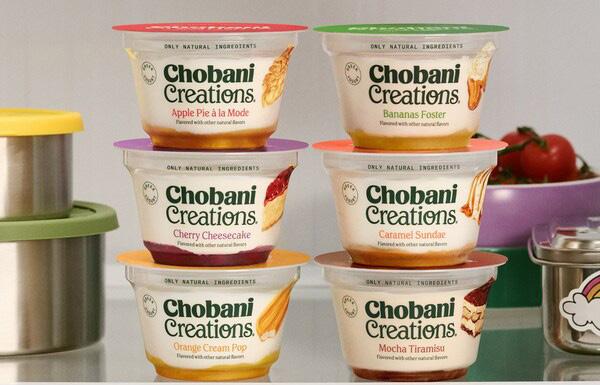
Chobani has a new indulgent option for consumers.
Called Chobani® Creations® Greek Yogurt, the line features six flavors: Mocha Tiramisu, Apple Pie à la Mode, Cherry Cheesecake, Orange Cream Pop, Bananas Foster, and Caramel Sundae.
“By pairing our natural, nutrient-dense Greek Yogurt with dessert-inspired flavors, we’re stretching yogurt beyond the breakfast occasion,” said Niel Sandfort, chief innovation officer, in a press release. “These flavor profiles, whether they be nostalgic like orange cream pop or decadent like mocha tiramisu, hit the spot in terms of food memory, sensory, and satisfaction. With Chobani Creations, we’re giving consumers a permissible, indulgent moment.”



One company that is experimenting with different flavors is Cracker Barrel Cheese.
In March, it introduced a Truffle Cheddar and Dill Havarti.
“As the appetite for innovative flavor combinations continues to rise, we can’t wait for Cracker Barrel fans and cheese lovers alike to experience our new artisan flavors, promising an elevated snacking experience that exceeds expectations,” said Mallory Loeffler, brand manager, in a press release.
To meet that demand, Tillamook recently introduced a brick cream cheese that is free of gums and preservatives.
Berry noted that cheese sales are continuing to grow in 2024 because, after all, “people love cheese.” Even so, a few new trends have emerged. The first is experimentation with flavors – specifically those that are spicy and hot (like peppers).
“When you eat spicy foods with dairy, the dairy helps mellow it out, so you can taste the peppers a little bit better,” said Berry. “So, companies are getting really creative right now in that space.”
They are also experimenting with different forms of cheese.
“There’s been a lot of activity with the concept of cheese snacking bars,” said Berry. “Instead of it looking like a string cheese or little cubes, it’s more of a bar, so you’re eating it like you would like a granola bar.”
Butter is another space where that experimentation is continuing, particularly with “different flavors for different uses.” Also doing well is ghee, a clarified butter that is ideal for cooking and frying.
“People are gravitating toward real butter,” Berry concluded.
Refrigerated dairy desserts continue to be one of the biggest opportunities for dairy processors, according to Berry – and they are finally beginning to gain some momentum.
“During COVID, consumers really got used to all of the single serve, grab-and-go concepts,” she added. “And because everyone believes that they can have a treat (there is research that says this), this whole space of dairy desserts and portion control is really resonating with consumers.”
As a result, companies are getting more and more creative when it comes to incorporating different layers and flavors. For example, Rich Foods recently launched a turtle cheesecake mousse parfait, which its website describes as “perfectly portioned and portable cheesecake mousse on a bed of chocolate crumb, topped with a smooth layer of caramel and sprinkled with chocolate chips and pecans.” And more innovations are sure to follow.

Editor’s note: Thank you to Donna Berry for sharing her knowledge on this topic. You can read her blog at berryondairy.com

Courtney Kless is the Managing Editor of Northeast Dairy Media.

dsm-firmenich has selected Peach+ as its 2024 “Flavor of the Year.”
“Now in its 12th year, the announcement of the Flavor of the Year is an eagerly anticipated event,” said Maurizio Clementi, EVP for Taste, Taste, Texture & Health at dsm-firmenich. “The delicate and natural qualities of Peach+ call for diverse applications across multiple food and beverage industries, and we are excited to see the innovations of our clients upon receiving this news.”
The peach is one of the oldest cultivated fruits in the world, with a 4,000-year-old history that began in China and continues to this day. China is the world leader in peach production and exportation, with over 400 varietals under cultivation.
“Our research reveals that peach has many multifaceted meanings,” said Jeffrey Richard Schmoyer, VP of Human Insights for Taste, Texture & Health at dsm-firmenich. “And peach is incredibly emotional. While the peach has a long history, it also has an innovative future.”
According to Emotions 360™, a proprietary dsm-firmenich consumer study that measures consumer emotions associated with ingredients, the peach is somewhat unique in that it has many innate qualities that contrast, such as being both indulgent and pampering, but also refreshing and revitalizing, and youthful, but nostalgic.
Peach has been an evergreen fruit flavor in many categories for decades with a steady share of presence in innovations in most regions. Today, peaches are growing in popularity in some regions and categories both as the primary tonality and in combination with others. The most prevalent areas of growth for peach new product development are carbonated soft drinks, nectars, candies, readyto-drink teas, teas, flavored alcoholic drinks, yogurt and fruit preparations, dairy drinks, juices containing peach, and fruit preserves. Other areas showing promise for growth are functional drinks and powdered soft drinks, as well as more savory opportunities for peach including side dishes, noodles, processed cheeses, and protein analogs. Peach in combination also spiked in favor of passion fruit plus peach, mango plus peach, peach plus tea, and apricot plus peach.


June 2: National Rocky Road Day
June 4: National Cheese Day
June 7: National Chocolate Ice Cream Day
June 20: National Vanilla Milkshake Day
June 27: National Ice Cream Cake Day
July 1: National Creative Ice Cream Flavors Day
July 7: National Strawberry Sundae Day
July 17: National Peach Ice Cream Day
July 21: National Ice Cream Day
July 23: National Vanilla Ice Cream Day
July 25: National Wine & Cheese Day and National Hot Fudge Sundae Day
July 30: National Cheesecake Day
Aug. 2: National Ice Cream Sandwich Day
Aug. 14: National Creamsicle Day
Aug. 18: National Ice Cream Pie Day
Aug. 19: National Soft Ice Cream Day
Aug. 25: National Banana Split Day
Source: nationaldaycalendar.com
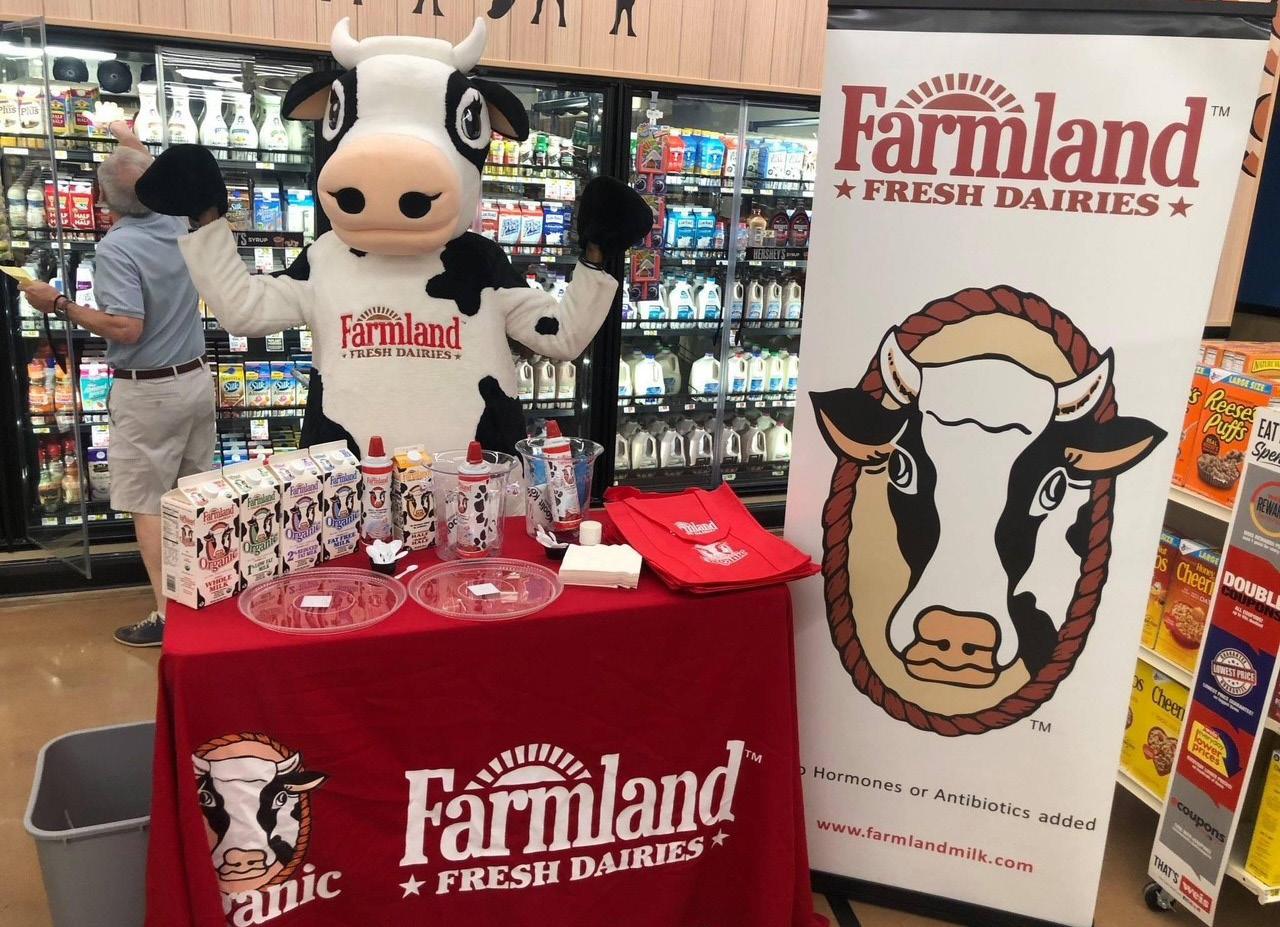
Bartlett Dairy has a saying: ‘We’re not just milk.’
During its 61-year history, the company has evolved from a milkman service into a regional food and dairy distributor – and it’s been managed by the same family the entire time.
“Milk runs in the veins of the Malave family, but it wasn’t enough to keep up with the demands of our everchanging customers,” said Michael Malave, VP Sales. “The added value to our product mix makes us a key partner to the customers we serve.”
His father, Thomas Malave Sr., established Bartlett Dairy in 1963 with a single truck (at the time, it operated as a doorto-door delivery service and retail route in Queens, New York.). Soon after, Tommy Malave Jr. followed in his footsteps, and together they broadened the company’s market to include stores and restaurants.
By 1990, the decision was made to incorporate the company. That ushered in another era of growth for Bartlett Dairy. Malave’s other sons – Michael, Kenny, Jimmy, and Donald – joined the team, bringing with them a wealth of knowledge acquired during their time at other dairy operations.
“Although the company has grown well beyond the founder’s expectation, it is still a family business,” said Malave. “Throughout the years, each son took a more active role in the family business. This led to its continued growth and success in building one of the largest family-owned dairy distribution organizations in the region.”
Now serving customers in New York, New Jersey, and Connecticut, Bartlett Dairy has stayed true to its roots, specializing in milk (the company’s website boasts that it is
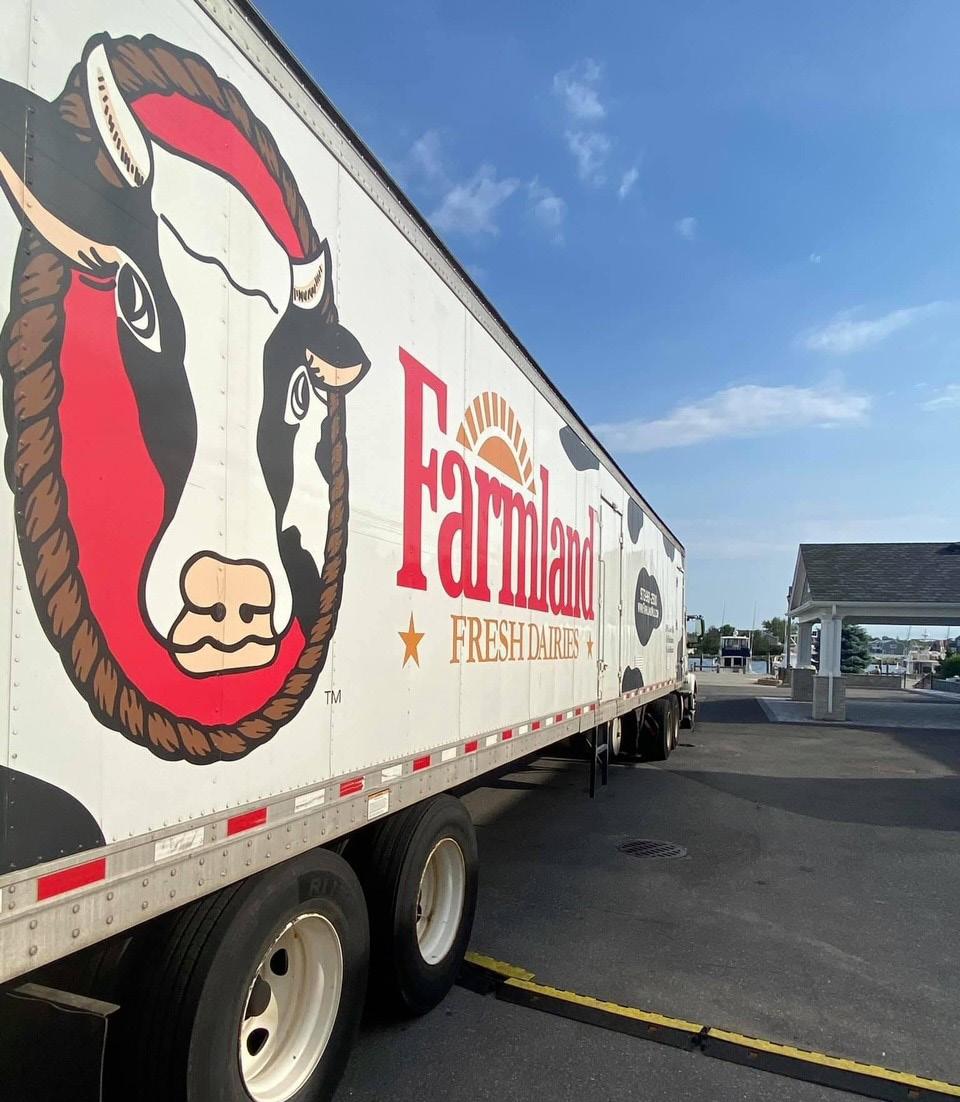

“Milk runs in the veins of the Malave family, but it wasn’t enough to keep up with the demands of our everchanging customers.
The added value to our product mix makes us a key partner to the customers we serve.”
–Michael Malave, VP Sales, Bartlett Dairy
how much it has grown over the years. New hires undergo training directly from the Malave brothers and its team is available around the clock, ready to provide assistance whenever needed.
“often two days fresher” than other brands) and milk products. But the Malave brothers also knew that the business needed to adapt. So, it did.
“By enhancing our portfolio to meet the needs of our clientele, we began distributing other perishable food items to retail and foodservice customers in the region,” said Malave. “We supply syrups, baking ingredients, juices, fresh fruit, soups, paper products, and many other products found in the kitchens that we service.”
And the company is diversifying its offerings again, this time with a line of shelf stable products.
“As always, when adding new products to our brand, Farmland Fresh Dairies, a lot of work goes into it before we get to taste the final product,” said Malave. “It all starts with a vote from the brothers. Then the vision becomes a reality after R and D is done to make sure the product meets the standards of our family values. Once everyone is in agreement, design and packaging is assembled and voted on by the organization. After months of preparation and planning a launch date, we have our new Farmland Fresh Dairies shelf stable product ready for its introduction to the industry.”
Bartlett Dairy’s mission statement contains six core values, but one of them, the commitment to excellence in customer service, is especially important to the company – no matter
“We never miss a beat when it comes to service,” said Malave.
“Growing the business successfully is a shared culture throughout the different departments that make us ‘One World.’ Every employee of Bartlett Dairy has their own talents that they bring to the table. We depend on everyone to roll up their sleeves to support each other and take care of our customers.”
And Malave said the future looks even brighter. The company’s new distribution center is nearing completion and is expected to begin operations soon.
“The brothers wanted to establish a facility within the combines of New York City to better serve our New York metro and New York suburban customers,” said Malave. “Once we open this distribution center, we look forward to growing our business, expanding our product offerings, and bringing jobs back to the community where we were established years ago in a milk plant in Queens, New York.”


Courtney Kless is the Managing Editor of Northeast Dairy Media.

he Probst Group is deeply committed to two things: clean water and the protection of natural resources.
“Combining our passion for preserving the environment with our unparalleled expertise in wastewater treatment allows us to provide some of the most advanced wastewater treatment solutions in the country,” said Brand Manager Samantha Winchell.
That expertise comes, in part, from knowledge passed down by three generations of wastewater engineers.
Henry Probst was immersed in the world of wastewater treatment as a child, accompanying his father and grandfather on visits to treatment plants.
“He quickly became fond of the unique challenges every facility provided,” said Winchell. “As he grew up, providing technologically advanced wastewater solutions became a passion for him; knowing that he could assist more facilities in effectively treating their wastewater and help protect the
environment at the same time.”
Henry went on to major in Civil Environmental Engineering at the University of Wisconsin – Milwaukee, juggling his studies with employment at ProCorp., a company his father, Tom Probst, founded in 1988 to offer wastewater management solutions to the food and beverage industry.
During that time, the father-son duo also pioneered a few of the earliest processes for enhanced biological phosphorus removal.
Following the sale of ProCorp, Tom and Henry established The Probst Group in 2008, and by 2014, Henry assumed full ownership. In January, the company moved into its new headquarters in Hartland, Wisconsin.
“For years, we’ve made do with spaces that never quite fit. But we dreamed of something better, a place that could truly support our growth and nurture our talent,” said Winchell. “Probst’s innovative office is equipped with cutting-edge technology to enhance communication, streamline processes,

“Cheese, milk, ice cream – they’re all amazing! But dairy processing and production utilize a significant amount of water during the production and cleaning processes, creating process wastewater, which must be treated before it can be discharged. That’s where we come in.”
– Samantha Winchell, brand manager at the Probst Group
reduce our environmental footprint, and ensure that our team has the tools they need to provide the highest level of service to our clients.”
More than 85% of them come from the dairy industry.
“Cheese, milk, ice cream – they’re all amazing! But dairy processing and production utilize a significant amount of water during the production and cleaning processes, creating process wastewater, which must be treated before it can be discharged,” said Winchell. “That’s where we come in.”
During its 16-year history, The Probst Group has created a comprehensive suite of solutions that includes engineering, design, build, operations support, consulting, and assistance with compliance and permitting. Each can be customized to meet the unique needs of the customer (and the facility).
“It’s definitely not a ‘one-size-fits-all’ type of approach,” said Winchell. “It really is our driving force to be your partner for wastewater solutions. Today and tomorrow. We design each system and solution with pride, knowing that we provide our clients with a clear path for process and capacity expansion as they continue to grow in the future.”
Winchell said that as a provider of wastewater solutions, The Probst Group is uniquely positioned to help its clients meet their sustainability goals. But the company also has some of its own.

“We also make a conscious effort to protect the environment through our own actions,” she added. “Our team is passionate about reducing the impact that we leave, and we continue to implement green initiatives and ideas in our workplaces and homes through our Green Team. Some of these efforts include reducing plastic and Styrofoam waste, as you’ll no longer find any disposable bottles in our office, and we’ve outfitted our team and workspaces with reusable, insulated water bottles and ceramic mugs. Additionally, our team participates in a handful of events, such as local river cleanups, to help ensure that we’re protecting the environment.”
The company’s five core values (Be Team Focused; Be Passionate; Be Accountable; Be Kind; and Grow) are at the heart of everything it does.
“Maybe one of the most unique aspects of our culture is the overarching spirit it has created,” said Winchell. “Ask anyone in the company what their favorite part of working here is, and the answer will be a resounding, ‘The people I work with.’ And that mentality combined with our shared values and commitment to the environment and the work that we do allows every member of The Probst Group to feel heard, to challenge something if they disagree, and creates an allfor-one effect; you’ll never hear someone say, ‘That’s not my job.’ And having a great team who works together and enjoys their work transitions directly to the way we interact with our clients, our partners, our vendors, and the community.”


Courtney Kless is the Managing Editor of Northeast Dairy Media.

MACNY, The Manufacturers Association, is pleased to announce Carl Byrne, president/CEO of Byrne Dairy, Inc., as the 2024 Manufacturers Wall of Fame inductee, and Tyler Robillard, director of engineering of Feldmeier Equipment, as this year’s Innovator of the Year.
Over the years, Carl Byrne has transformed the company from a small local milk company to a major dairy supplier throughout the United States and beyond. As a member of the third generation of the Byrne family to operate the dairy, Carl began his career developing a customer base and managing a convenience store in the Rochester area.
Later, as vice president of sales, Carl’s vision of moving into extended shelf-life (ESL) dairy and non-dairy products resulted in the construction of the Byrne DeWitt facility in 2004. Since becoming President in 2008, Carl has overseen five expansions at the plant, which now includes more than 200,000 square feet of processing, production, packaging, and warehouse space, and employs more than 250 Central New Yorkers. Additionally, Carl has directed the growth of a sister ESL facility in Cortlandville, as well as Byrne’s Ice Cream Center in Syracuse.
In 2021, at the height of the COVID-19 pandemic, when other manufacturers were cutting back on employees and facilities, Carl saw the opportunity to further expand Byrne’s footprint by entering the aseptic dairy market. Using the most technologically advanced equipment available, Byrne is now

producing shelf-stable (no refrigeration needed) dairy products that can be shipped around the world. This bold move has positioned Byrne to be at the forefront of dairy manufacturing by giving customers in the United States and beyond the ability to buy ESL and aseptic dairy products.
Carl’s focus on his employees is never-ending. He has strengthened Byrne’s safety, HR, and training teams, brought compensation up to meet/exceed local markets, supported his teams to help offset rising fuel and food costs, maintained an annual and semi-annual bonus program, and has provided channels for employees to bring their ideas for improvement to the forefront. His commitment to the community and customers has never wavered. Byrne donates to schools and community groups throughout each year.
With his induction into the Manufacturers Wall of Fame, Carl will be joining a prestigious group of manufacturing leaders who have been honored since the Wall of Fame’s inception in 2001. The Manufacturers Wall of Fame celebrates individuals who have demonstrated long-term dedication to manufacturing in Central and Upstate New York. To view a listing of previous Wall of Fame Inductees, visit macny.org/ about/wall-of-fame/
Byrne Dairy
Lactalis USA was recognized for its dairy producing expertise at the World Championship Cheese Contest, the world’s premier technical competition for cheese, butter, and yogurt.
Lactalis USA secured 21 medals, including eight gold medals and nine silver medals across its broad portfolio of award-winning dairy products. Lactalis’ premier global brands, Galbani and Président, were recognized with eight medals. In addition, Lactalis USA’s Karoun Dairies division, which manufactures a wide variety of Mediterranean specialty cheeses and cultured dairy products, was awarded eight medals. The honors include two gold medals for its Karoun Labne Tzatziki and Gopi Low Fat Yogurt. Lactalis also received a silver medal for Kraft Grated Parmesan & Romano, along with three medals for whey powders (two gold, one silver).
“We take great pride in our diverse range of brands that exemplify Lactalis’ commitment to providing nutritious dairy products to people in all communities. Winning multiple medals underscores our dedication to crafting world class cheese and dairy products,” said Esteve Torrens, Lactalis USA chief executive officer. “These awards are a testament to the hard work of our team as we remain steadfast in our commitment to providing the very best dairy products for our valued customers and consumers, while advancing innovation in the dairy industry.”
O’ LAKES CEO
IN TIME100 LIST OF THE 100 MOST INFLUENTIAL PEOPLE IN THE WORLD TIME named Beth Ford, Land O’Lakes President and CEO, to the 2024 TIME100, its annual list of the 100 most influential people in the world. The list recognizes the impact, innovation and achievement of the world’s most influential individuals.

“I am honored to be mentioned among this impressive group of people,” said Ford. “The list recognizes influence is most critical on issues that affect everyone, like the global food supply. Our farmers, cooperatives and ag retailers carry the most risk in the food system. Without investment in rural America – its communities, its business-
es, and its families – the interconnected global food chain is vulnerable. We all owe so much to the grit, determination and resilience of the people who feed us all.”
Ford, who has held senior positions in seven companies in six industries, leads not only by delivering financial performance, but also by addressing the important global issues and structural changes that can improve areas directly impacted by food and agriculture. During her tenure, Land O’Lakes has focused on its members, the technology that enables them, and on ensuring the vibrance and connection of the communities in which they live and work. Working to close the digital divide, she convened the American Connection Project and contributed to the passage of the Infrastructure Investment and Jobs Act which included $65 billion for rural connectivity. She regularly addresses issues around global food security, noting food security is national security.
In April, New York Governor Kathy Hochul and representatives from the Coca-Cola Company and fairlife marked the groundbreaking on a new fairlife production facility, a $650 million investment in Webster. The 745,000 square-foot facility will serve as fairlife’s flagship Northeast location and is expected to be operational by Q4 of 2025.
“We are thrilled to be laying the foundation for fairlife’s next phase of growth as we begin construction of the Webster facility, enabling greater distribution of our products in the Northeast and across the country,” said Tim Doelman, fairlife chief executive officer. “We are grateful for the collaboration and support we have received from the town of Webster throughout this process and continue to value our growing partnership with the Webster community.”
Nelson-Jameson, the premier single-source supplier for food, dairy, and beverage processing plants, has launched a new mobile app designed to provide customers with quick, convenient access to the company’s products and services. The app’s introduction aligns with the redesign of nelsonjameson. com earlier in 2024, enhancing online browsing, usability, and
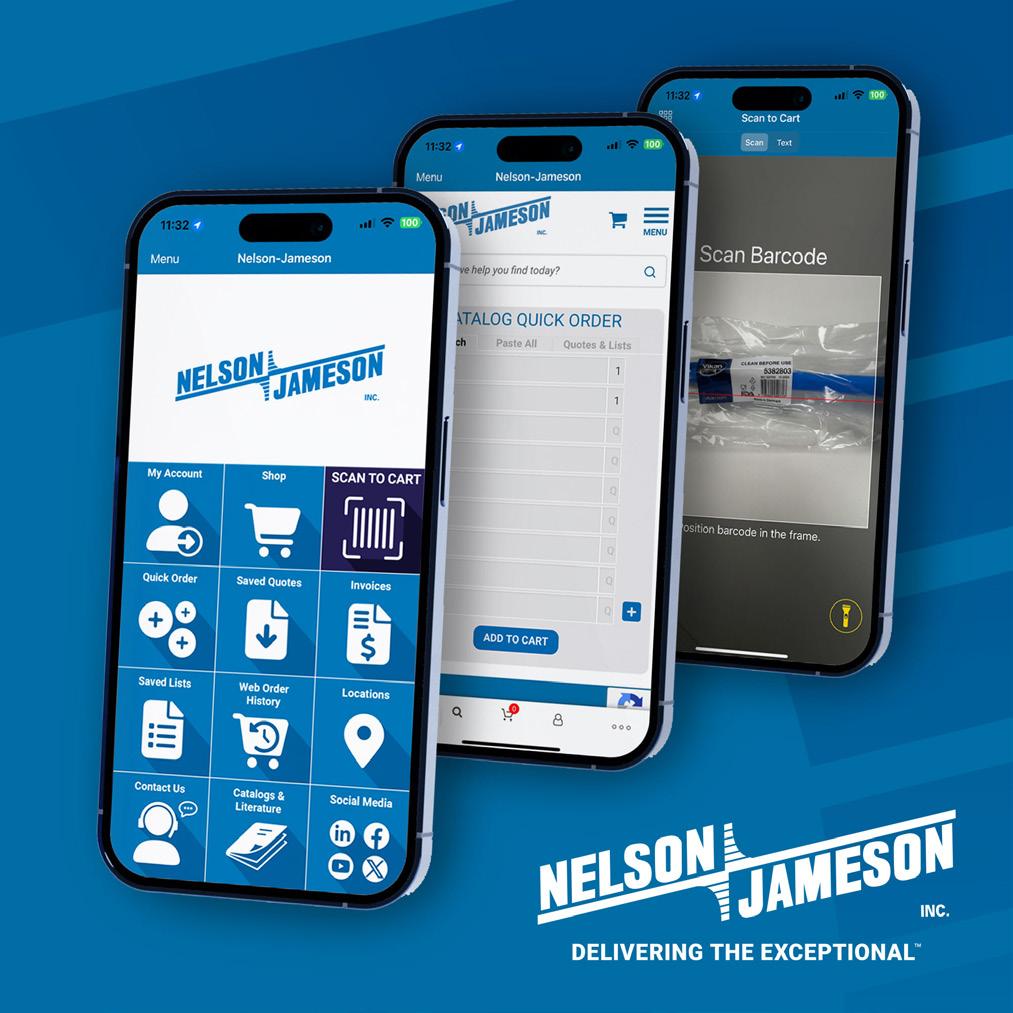
shopping and granting access to saved account details.
“We are delighted with the positive response we’ve received regarding our new web experience,” said President Mike Rindy. “We’re pleased to build upon that and offer the added convenience and flexibility of a mobile app to our customers. Nelson-Jameson has succeeded for more than 76 years by upholding our core values while adapting to industry change, and the app reflects our customer-centric ethos and dedication to scaling our customer solutions for growth.”
Existing customers can manage all aspects of their accounts, including order history, saved product lists, pricing quotes, past invoices, and more. Another unique feature is barcode scanning, which allows customers to scan product barcodes for instant access to detailed information and restock with a few clicks. Customers can also Quick Order by pasting a list of products into the Quick Order Pad or by adding everything to the cart from a saved shopping list or a saved quote.
WestRock Company, a leading provider of sustainable fiber-based packaging solutions, has ranked among the top 200 U.S. companies on Fortune’s list of America’s Most Innovative Companies 2024.
“WestRock prioritizes innovation to deliver game-changing solutions that help solve customer challenges and contribute to growth,” said David B. Sewell, president and chief executive officer. “This award is a testament to our deep
customer relationships and the dedication of over 50,000 team members whose knowledge and expertise is helping WestRock achieve new heights in sustainable packaging.”
America’s Most Innovative Companies 2024 were selected based on product innovation, process innovation and innovation culture leveraging employee and industry surveys, as well as a qualitative evaluation of companies’ IP portfolios. The full list can currently be viewed on the Fortune website
WestRock also announced plans to build a new corrugated box plant in Pleasant Prairie, Wisconsin to meet growing demand from customers in the Great Lakes region. The company intends to close its existing plant in North Chicago when construction of the new facility is completed. This investment will position WestRock to increase its production capabilities and improve its cost profile in the Great Lakes region.
QualiTru Sampling Systems, a global leader in aseptic and representative sampling solutions for the food and dairy industries, announced the recent additions of two sales account executives and a quality manager to its growing team.
In a move to strengthen customer relationships and expand market reach, QualiTru has welcomed two accomplished strategic account executives. The new additions, Rikka Kerber and Sheila Berger, bring a wealth of experience in sales and customer service that align seamlessly with QualiTru’s commitment to innovation, efficiency, and the highest standards of safety and processes. Furthering its dedication to quality and ongoing product development, QualiTru has appointed Andy Gioino to enhance quality assurance processes and accelerate our product pipeline.
“As QualiTru continues to evolve and grow, the expertise brought in by Rikka, Sheila, and Andy will play crucial roles in driving our success,” said CEO Ian Davis. “We remain committed to providing unparalleled customer support, world-class product quality, and product innovation to help the industry produce high-quality, safe products for global consumers.”
Van Alstine – a division of NextGen Label Group™ – announced a significant transition in its leadership team. Gary Riley, Sr., president, will retire, marking the end of a distinguished tenure, while Dan Rosenbaum, CPA, will assume the role as the new president.
“Gary’s contributions have been instrumental in shaping the success of the Van Alstine division, and his departure marks the end of an era,” said Tom Sargent, CEO and president of NextGen Label Group™. “Beyond his professional achievements, Gary has been a mentor, a confidant, and a source of inspiration to his team. His guidance, wisdom, and genuine concern for the well-being of every team member have left an impact that will continue to resonate long after his departure.”
Upon Gary’s retirement, Dan Rosenbaum, who currently serves as CFO for NextGen Label Group™, will step into the role of president of the Van Alstine division. Rosenbaum will maintain a dual role of president of the Van Alstine division and CFO of NextGen Label Group™.
Ecolab Inc., a global sustainability leader offering water, hygiene and infection prevention solutions and services that protect people and the resources vital to life, announced that
it has been named one of the World’s Most Ethical Companies by Ethisphere, a global leader in defining and advancing the standards of ethical business practices. Ecolab has earned the title for 18 consecutive years since Ethisphere’s inaugural award in 2007.
“At Ecolab, we consider ethical business practices to be a cornerstone of what it means to be a responsible and profitable company,” said Christophe Beck, chairman and CEO. “Our commitment to doing the right thing, and doing it well, is how we are able to deliver on our promises and expand our positive impact on the world.”

Have you recently won an award?
Do you have any new products coming out?
Are you planning an expansion?
Email courtneyk@nedairymedia.com with more information.

Perry’s Ice Cream Company launched a new line of perfectly portioned, exceptionally indulgent ice cream bars. Each bar is crafted with a decadent, extra indulgent formula, loaded with signature pieces, and dipped in a thick chocolate coating. Available in five delicious flavors (Bittersweet Sinphony; Brownie Batter; Deep Sea Treasure; Let's Dough Buffalo!®; and Panda Paws), each bar is inspired by one-of-a-kind signature Perry’s favorites.
“Using our most decadent ice cream and enrobed in a thick chocolate coating, these bars feature signature flavors consumers know and love from Perry’s, providing the premium experience they are looking for,” said Nichole Buryta, senior brand manager.
La Colombe® Coffee Roasters, a specialty coffee roaster, announced the national availability of new 11 fl oz Draft Latte
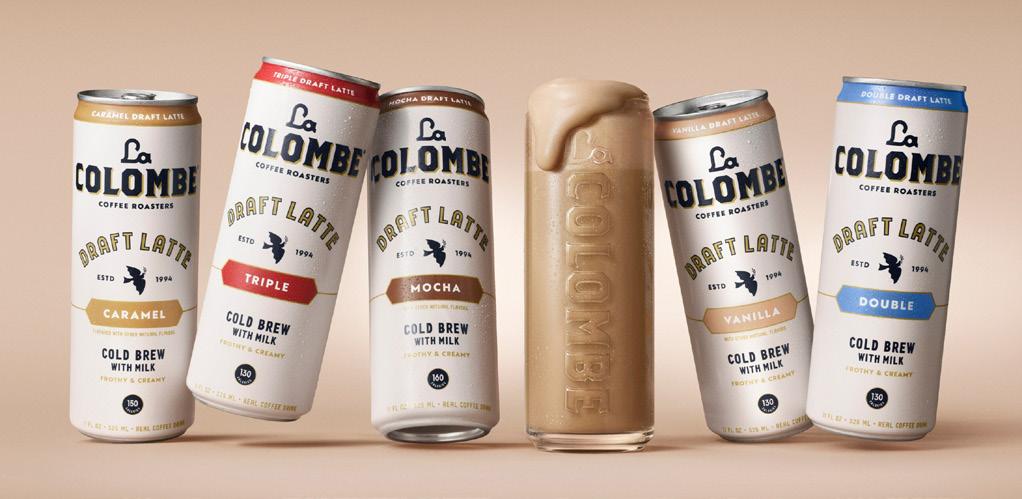
cans. With the same creamy texture and smooth taste as the Draft Lattes on-tap in La Colombe cafés, the first product launched under Chobani leadership delivers on the growing consumer demands for cold coffee and less sugar. The Draft Latte cans are available in Double, Triple, Mocha, Vanilla, and Caramel.
“Chobani and La Colombe is a perfect union of like-minded brands–they share a commitment to quality, craftsmanship, and impact, as well as a belief that delicious, nutritious products should be available to all,” said Hamdi Ulukaya, Chobani founder and chief executive officer. “Just as Chobani disrupted the yogurt industry back in 2007, we’re excited for La Colombe to disrupt the high-growth ready-to-drink coffee category with a better choice for people who are looking for more cold coffee options.”

The Syracuse Press Club recognized Northeast Dairy Magazine at its 2023 Professional Recognition Awards in May, naming the Q1 issue as the winner in the “Best Newsletter or Trade Publication” category. Entries were judged by press clubs in California, Florida, Idaho, Louisiana, Ohio, and Wisconsin.
They had the following comments: “Great mix of articles, with a cohesive format. A clean, inviting publication with something for everyone in the industry.”
You can read the full issue here: issuu.com/nedmagazine/ docs/ned-q1-2023-issuu

The following new members recently joined the Northeast Dairy Foods Association, Inc., or the Northeast Dairy Suppliers Association, Inc. For more information about the benefits and services available from both the Northeast Dairy Suppliers Association, Inc., and the Northeast Dairy Foods Association, Inc., contact Leanne Ziemba at 315-452-MILK (6455) or leanne.ziemba@ndfsa.org.
McKenzie Findley Senior Associate mckenzie.findley@alliantgroup.com
3009 Post Oak Blvd., Suite 2000 Houston, Texas (832) 373-7969 alliantgroup.com
Robert Cundall Field Sales Representative bcundall@rhfs.com 5 Fairchild Square, Suite 2 Clifton Park, New York (716) 560-2998 rhfs.com
Jan King Owner
311 King Road Schuylerville, New York (518) 695-6455 kingbrothersdairy.com
Ethan Crist Corporate Accounts Manager ethan.crist@veritivcorp.com 1000 Abernathy Road NE Building 400, Suite 1700 Atlanta, Georgia VeritivCorp.com
Mark Klinger
Business Development
Mark.klinger@ifm.com 1100 N. Atwater Drive Malvern, Pennsylvania ifm.com/us



The NDFSA has a
where you can purchase limited edition membership merchandise*


*The store will be open until May 27, then it will reopen in the fall with additional items.


The Northeast Dairy Foods and Suppliers Associations hosted their first event of the year, the Dairy Blender, on March 26 in East Syracuse, New York. Executive Director Alex Walsh said it was “extremely successful.”
“Members were able to hear directly from processors and manufacturers about their company and really learn about their operations, products, and needs,” he added. “A huge thank you to Byrne Dairy, Chobani, Dairy Farmers of America, and Great Lakes Cheese for giving informative and insightful presentations. This event has really grown over the years, and we saw 150 people in attendance, which was followed by networking with suppliers, processors, manufacturers, and industry leaders, and proves to be a great opportunity to meet and build relationships to drive growth for all.”
Up next are the Bruce W. Krupke Memorial Golf Tournament & Clambake (July 10) and the Northeast Dairy Convention (Sept. 25-27). Turn to pages 39-41 to learn more (and to register). We hope to see you there!








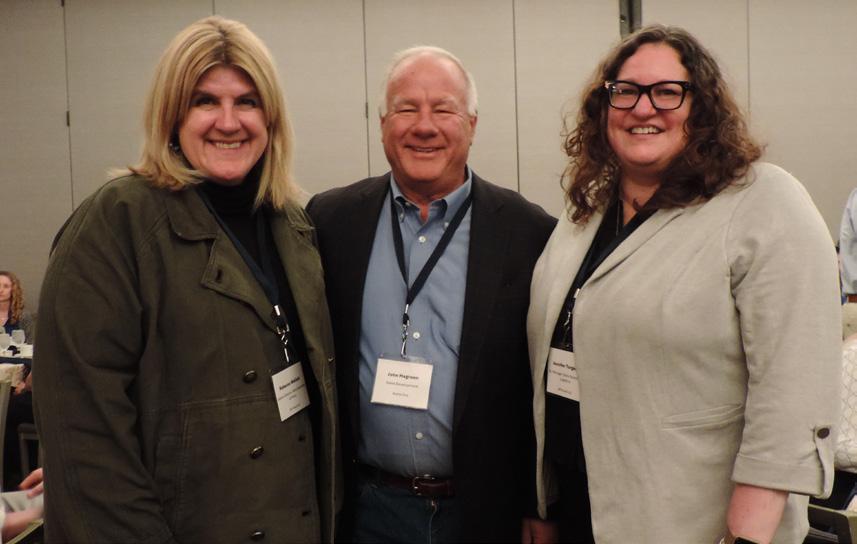
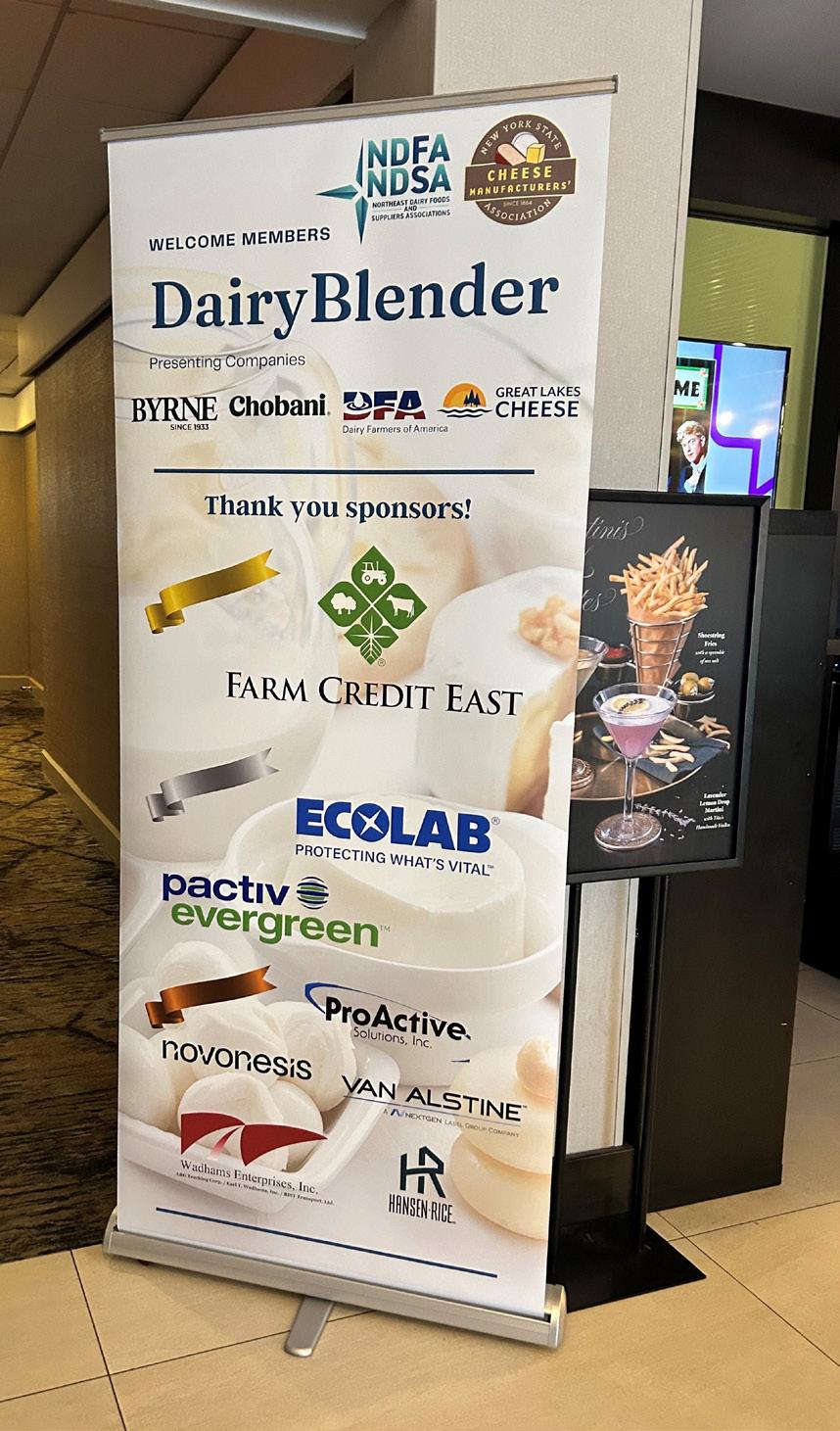
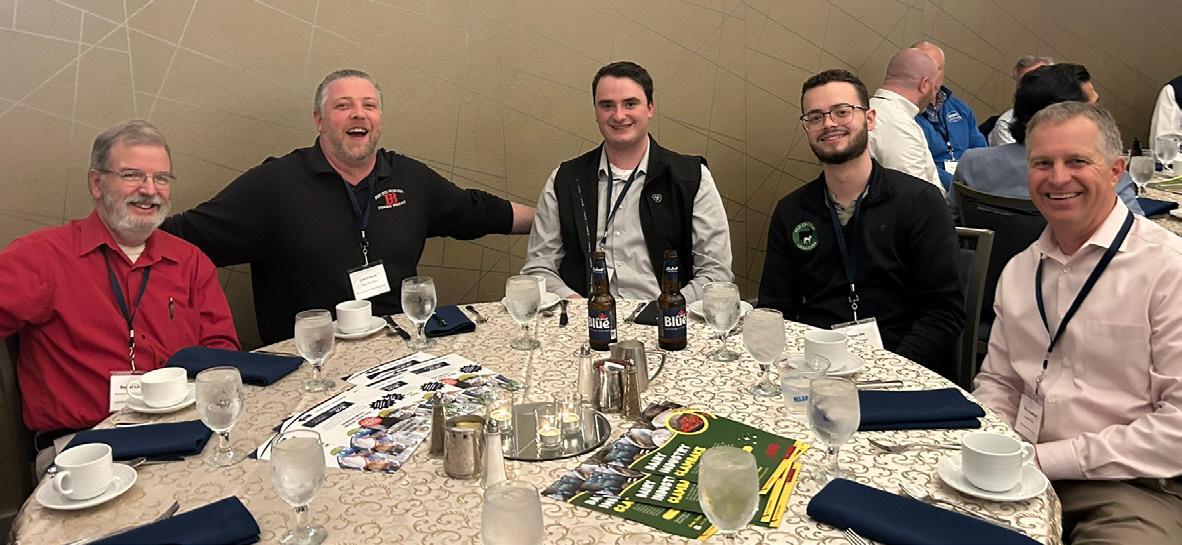
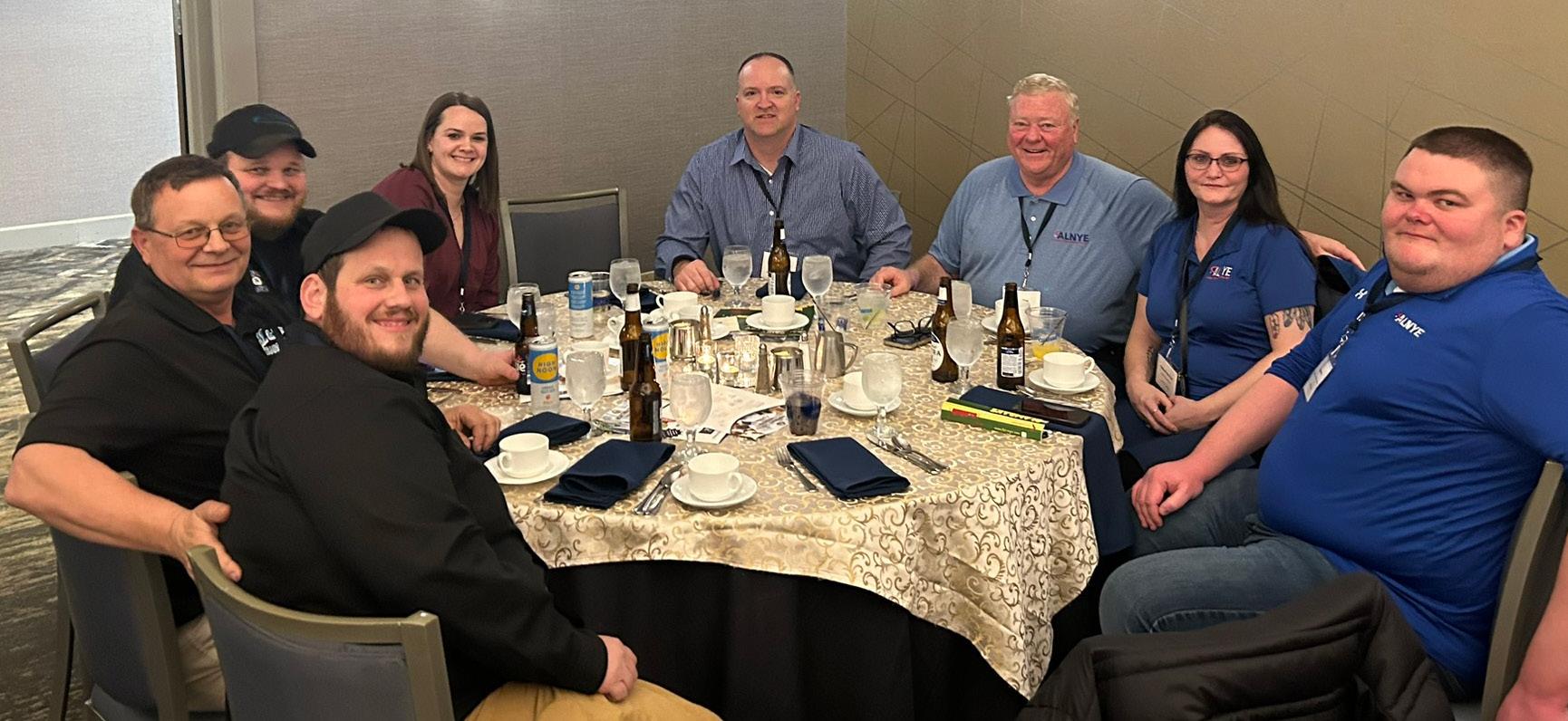
WEDNESDAY, JULY 10
Golf: 8 a.m.
Rogues Roost Golf Club (Bridgeport, New York)

Registration opens at 7 a.m., tee off is promptly at 8 a.m. The tournament will be a shotgun start of foursomes, with a captain and crew format. Individuals may register and form their own foursomes or be placed in one by the tournament director. Cash prizes will be awarded for the top team winners, longest drive, and closest to the pin. Golf Registration is $125 per person, which includes breakfast pizza, donuts, coffee, a cart, and non-alcoholic beverages on the course. You must be registered and paid by tournament day. Registration is limited to the first 192 players. Anyone who registers after the tournament is full will be placed on a wait list. We play in all weather conditions, except lightning.
REGISTER NOW
Clambake: 1 p.m.
Spinning Wheel Event Center (North Syracuse, New York)

Tickets are $110 each for ALL YOU CAN EAT – ALL DAY steamed clams, raw clams, clam strips, steamed mussels, clam chowder, hamburgers, hot dogs, coneys, BBQ beef, sausage with peppers and onions, chicken tenders, chicken wings, grilled chicken breast, various salads, milk, beer, soda, water, coffee, and a pig roast. Lobster tickets are $135 each, and include everything above, plus lobster served at 4 p.m.
The ticket price increases by $25 each for orders received after July 1, based on availability. Lobster ticket sales close at 5 p.m. on July 4, including at the door.
REGISTER NOW
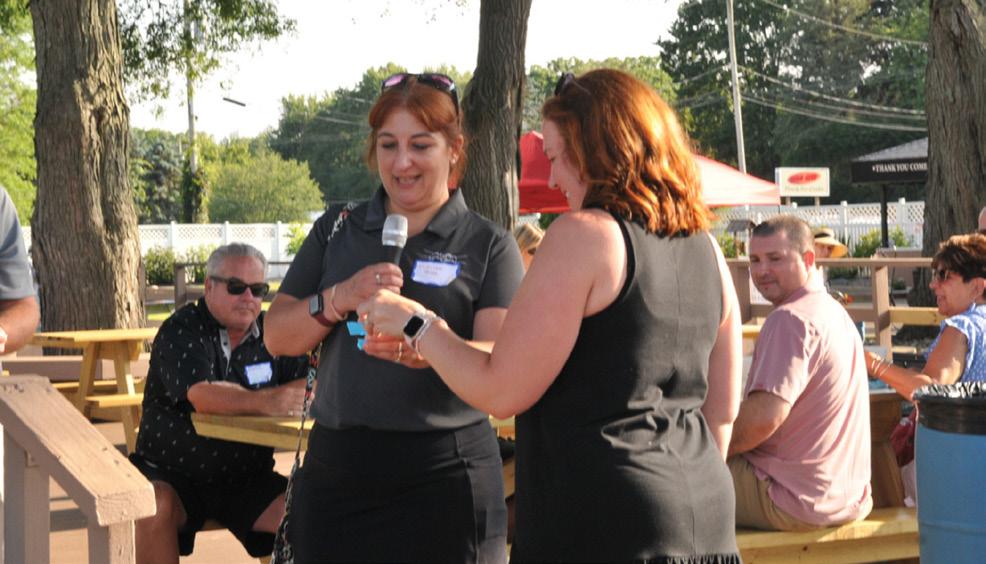


WEDNESDAY, SEPT. 25 – FRIDAY, SEPT. 27
Join us for three days of educational business sessions on key industry topics, a panel discussion, dairy industry networking, and some fun while visiting beautiful Saratoga Springs, New York.


Registration closes at 5 p.m. on Sept. 13
Hotel room reservations are to be made directly with the hotel. Room rate is $314 including taxes for two nights (up to two people). The room block is not guaranteed after Aug. 26.


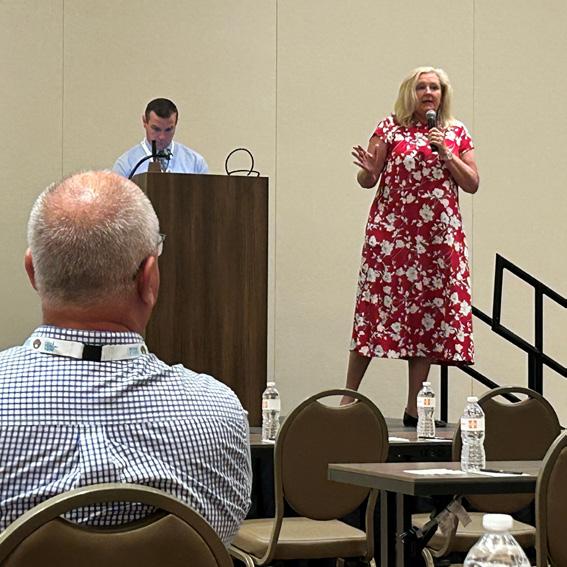
KARL CZYMMEK – PRO DAIRY
WEDNESDAY, SEPT. 25
noon – Vendor table setup
3 p.m. – NYSCM board meeting and hotel check-in
5:30 p.m. – VIP networking and cocktail party
6:30 p.m. – Dinner
THURSDAY, SEPT. 26
7 a.m. – Breakfast
8 a.m. – Business Session
- Dairy and greenhouse emissions, challenges and opportunities
8:45 a.m. – Vendor tables/exhibits
9:30 a.m. – Business Session
- Consumer trends in food and beverage and the dairy industry
- MilkPEP and how it helps the industry
noon – Golf tournament or Saratoga walking tour
5:30 p.m. – Cocktails
6:30 p.m. – Dinner
FRIDAY, SEPT. 27
7 a.m. – Breakfast
8 a.m. – Business Session
- Workforce development
- Workplace safety
9:30 a.m. – Panel discussion
- Legislative and dairy policy
11 a.m. – Vendor table teardown
NDFA board meeting
PAMD board meeting
Topic: Dairy and greenhouse emissions, challenges and opportunities
KIM BUKOWSKI – CORNELL UNIVERSITY
Topic: Workforce development
MAUREEN BALLATORI – AGENCY 29
Topic: Consumer trends in the dairy industry
DAVE CROWLEY – HP HOOD
Topic: Advancing workplace safety using leading indicators
AL DEJEWSKI – MILKPEP
Topic: How MilkPep is modernizing milk
LEGISLATIVE AND INDUSTRY POLICY PANELISTS
NEW YORK SENATOR GEORGE BORRELLO
Ag Committee Ranking Member
Other speakers TBA
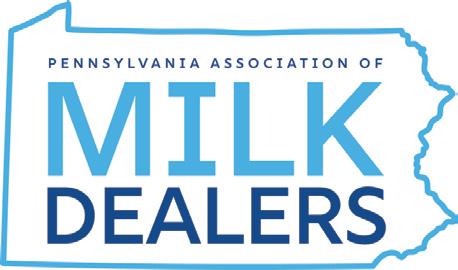

In the high-stakes world of pay-per-click (PPC) advertising, success hinges on precision. While the potential for reaching new customers and driving business growth is undeniable, navigating the intricate landscape of keywords, bids, audiences, and ad copy can feel like venturing into uncharted territory. Here's where data steps in, acting as your guiding light and propelling you toward PPC mastery.
Imagine launching an ad campaign without data at your disposal – essentially throwing darts in the dark. Occasionally, you might strike gold, but overall, it's an inefficient and costly approach. Data analysis in PPC illuminates the playing field, revealing:
• Winning Strategies: Data exposes which keywords generate the most clicks and conversions, along with the demographics most receptive to your message.
• Areas for Improvement: Are specific ads draining your budget with minimal return? Data identifies these underperformers, allowing you to optimize or eliminate them altogether.
• Hidden Gems: Data analysis can uncover opportunities to refine your bidding strategy, tailor your ad copy for higher resonance, or adjust your targeting to reach a more qualified audience.
Integrating data analysis seamlessly into your PPC routine is key. Here's how to get started:
• Set SMART Goals: Clearly define your campaign objectives. Do you seek website traffic, lead generation, or immediate sales? Establish Specific, Measurable, Achievable, Relevant, and Time-Bound goals.
• Track Key Performance Indicators (KPIs): Monitor metrics like click-through rate (CTR), conversion rate,
and cost-per-acquisition (CPA) to gauge your campaign's effectiveness in achieving your goals.
• Leverage Analytics Tools: Most PPC platforms provide robust built-in analytics dashboards bursting with valuable data. Tools like keyword planners help forecast performance and inform data-driven decisions. Consider third-party solutions for even deeper insights.
• Embrace A/B Testing: Test different ad copy variations, landing pages, and targeting options to identify what resonates best with your audience. Data will reveal the winning combinations.
While data is a powerful tool, it thrives on proper interpretation. Here are some expert tips:
• Context is King: Avoid basing decisions on isolated data points. Look for trends and patterns that emerge over time – typically at least quarter-over-quarter, or year-over-year for seasonal businesses.
• Consider External Factors: External events, seasonality, and competitor activity can all influence your PPC performance. Factor these elements into your analysis.
• Experimentation is Key: Data analysis is a continuous journey. Be prepared to adapt your strategy as you learn and new information surfaces. Don’t be afraid to do some A/B testing with your ad programs.
By embracing data-driven decision-making, you can transform PPC advertising from a guessing game into a welloiled machine. Leverage the insights data provides to finetune your campaigns, maximize your return on investment (ROI), and ultimately achieve your marketing goals. So, don't be afraid to turn on the lights – data is here to illuminate your path to PPC success!

Brian Bluff is the CEO and co-founder of Site-Seeker.


Part of developing a comprehensive digital marketing campaign is understanding how customers and potential customers are using the Internet to find your products and your website. The graphs and information below all come from Google Trends, which analyzes the popularity of queries in Google Search across various regions and languages. The graphs scale “Interest Over Time,” which represent search interest relative to the highest point in the chart for the given region and time-period. So, a value of 100 is the peak popularity for the term.
Another alternative is Google Keyword Planner. To use this tool, you must have a Google Ads account. The Keyword Planner lets you search keywords and suggests other words or phrases related to your products and services. It lets you research the trend information for how often certain words are searched and how those searches have changed over time and also gives you suggested bid estimates for each keyword, so you can determine your advertising budget.
In today’s digital environment, we strongly encourage members to capitalize on this growing trend and ensure that your company is visible in the place where people search the most.

Average Search Volume has increased 6.3% YoY
Search Volume has increased 65.3% over the past five years

Average Search Volume has increased 8.8% YoY
Average Search Volume has increased 60% over the past five years
RELATED SEARCH QUERIES
1. Lactose free milk
2. Lactose free dairy
3. What is lactose
4. What is lactose free

Average Search Volume has decreased 27.3% YoY
Average Search Volume has decreased 18.5% over the past five years
RELATED SEARCH QUERIES
1. What is networking
2. Business networking
3. Networking skills
4. Networking events

Average Search Volume has increased 24.2% YoY
Average Search Volume has increased 68.3% over the past five years
RELATED SEARCH QUERIES
1. Pay per click marketing
2. Pay per click management
3. What is pay per click
4. Pay per click campaign


Comfort Food Made with Delicious Dairy
INGREDIENTS
• ½ cup heavy cream
• ½ cup whole milk
• Juice from two oranges
• Zest from one orange
• 1 tsp. vanilla
• ¼ cup honey

INSTRUCTIONS
1. In a blender, add cream, milk, honey, and vanilla.
2. Zest one orange, then cut and squeeze two oranges into blender. Blend until well combined.
3. Pour into popsicle molds and freeze for at least 3 hours or until completely frozen.
4. Serve.
Many of our members may know Leanne Ziemba as the business operations manager for the Northeast Dairy Foods & Suppliers Associations. But we’ve discovered she also is queen of the kitchen, as she has some delicious recipes that include fresh, wholesome dairy products.

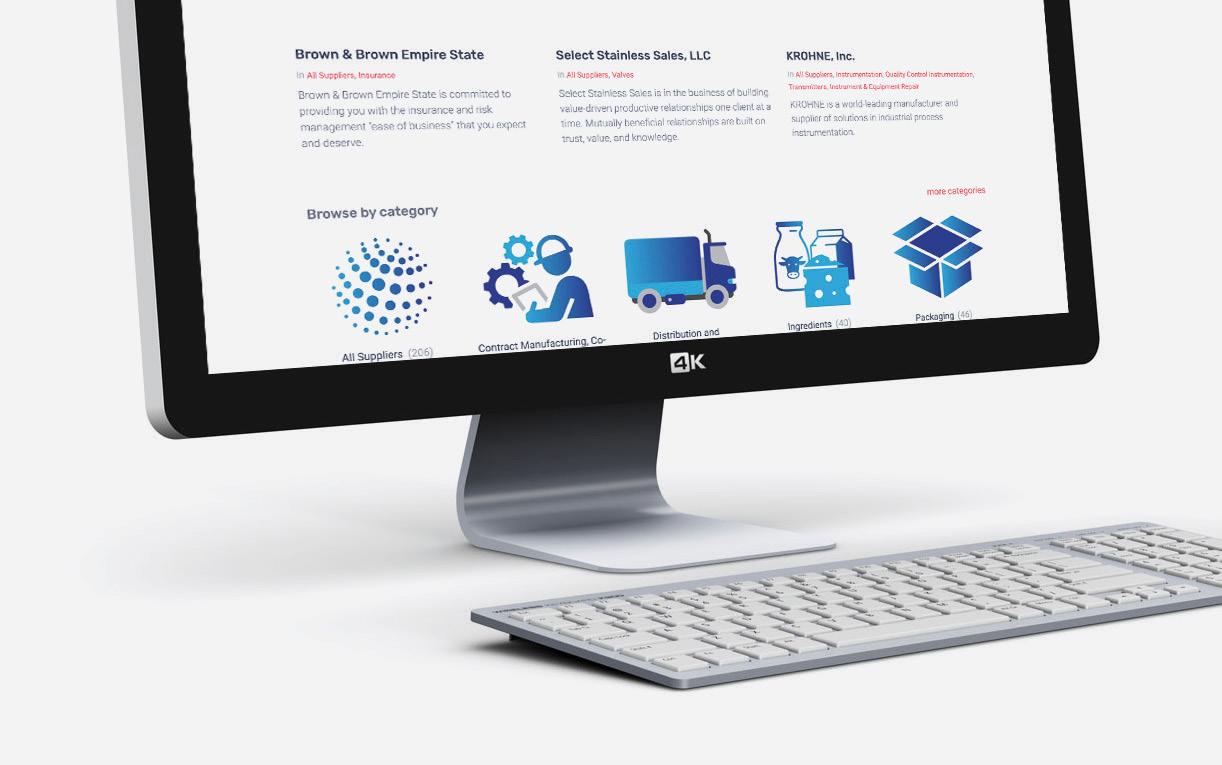

Dairy Producers can nd suppliers that will help their businesses run more pro tably and ef ciently.
• Co-Packing/Private Label
• Distribution and Transportation
• Ingredients
• R&D Quality Control
• Packaging
• Process Equipment
• Sanitation and Maintenance

• Service and Supplies
Weekly articles announcing the latest and greatest technologies from key industry suppliers.

Classi ed listings offering deals on used equipment.
And much more!



The U.S. Department of Labor published a final rule clarifying the rights of employees to authorize a representative to accompany an Occupational Safety and Health Administration compliance officer during an inspection of their workplace.
The Occupational Safety and Health Act gives the employer and employees the right to authorize a representative to accompany OSHA officials during a workplace inspection. The final rule clarifies that, consistent with the law, workers may authorize another employee to serve as their representative or select a non-employee. For a non-employee representative to accompany the compliance officer in a workplace, they must be reasonably necessary to conduct an effective and thorough inspection.
Consistent with OSHA’s historic practice, the rule clarifies that a non-employee representative may be reasonably necessary based upon skills, knowledge or experience. This experience may include knowledge or experience with hazards or conditions in the workplace or similar workplaces, or language or communication skills to ensure an effective and thorough inspection. These revisions better align OSHA’s regulation with the OSH Act and enable the agency to con-
In April, the Federal Trade Commission issued a final rule to promote competition by banning non-competes nationwide, protecting the fundamental freedom of workers to change jobs, increasing innovation, and fostering new business formation.
Under the FTC’s new rule, existing non-competes for the vast majority of workers will no longer be enforceable after the rule’s effective date. Existing non-competes for senior executives – who represent less than 0.75% of workers – can remain in force under the FTC’s final rule, but employers are banned from entering into or attempting to enforce any new non-competes, even if they involve senior executives. Employers will be required to provide notice to workers other than senior executives who are bound by an existing non-compete that they will not be enforcing any non-competes against them.
duct more effective inspections. OSHA regulations require no specific qualifications for employer representatives or for employee representatives who are employed by the employer.
The rule is in part a response to a 2017 court decision ruling that the agency’s existing regulation, 29 CFR 1903.8(c), only permitted employees of the employer to be authorized as representatives. However, the court acknowledged that the OSH Act does not limit who can serve as an employee representative and that OSHA’s historic practice was a “persuasive and valid construction” of the OSH Act. Today’s final rule is the culmination of notice and comment rulemaking that clarifies OSHA’s inspection regulation and aligns with OSHA’s longstanding construction of the act.
“Worker involvement in the inspection process is essential for thorough and effective inspections and making workplaces safer,” said Assistant Secretary for Occupational Safety and Health Doug Parker. “The Occupational Safety and Health Act gives employers and employees equal opportunity for choosing representation during the OSHA inspection process, and this rule returns us to the fair, balanced approach Congress intended.”
The rule is effective on May 31, 2024.

Source: osha.gov

In January 2023, the FTC issued a proposed rule which was subject to a 90-day public comment period. The FTC received more than 26,000 comments on the proposed rule, with over 25,000 comments in support of the FTC’s proposed ban on non-competes. The comments informed the FTC’s final rulemaking process, with the FTC carefully reviewing each comment and making changes to the proposed rule in response to the public’s feedback.
In the final rule, the Commission has determined that it is an unfair method of competition, and therefore a violation of Section 5 of the FTC Act, for employers to enter into noncompetes with workers and to enforce certain noncompetes.
Source: ftc.gov

VISIT NDFSA.ORG TO FIND OUT MORE
EXECUTIVE DIRECTOR AND INDUSTRY CONSULTANT SUPPORT
Legislative Representation Through Executive Lobbying and Networking
Safety and Environmental Information
Economic Analysis and Forecasting
Continuing Education and Certification Opportunities
Industry Spokesperson

Emergency Preparedness

NETWORKING AND MEETING EVENTS
Annual Northeast Dairy Convention
Contact Booth at the Annual Convention
Annual Dairy Industry Clambake
Hospitality and Sponsorship Opportunities
Annual Charity Golf Outing Fundraiser
COMMUNICATIONS AND PUBLIC RELATIONS
Quarterly copy of Northeast Dairy Magazine

Direct Customer Advertising Opportunities

Industry Scholarship Program
Membership Directory with Key Contacts in the Dairy Industry
Digital Buyers Guide
Weekly Dairy Newsletter


An association represents your interests before your government leaders, industry and business community. If your business/industry faces major threats or needs support, our association is right there on the front line fighting for you.




Association events, meetings and member directories make networking a reality for you and your peers. This is the one advantage many view as the most important reason to join!


NDFA and NDSA members shared these posts on LinkedIn

Yancey’s Fancy Wasabi Horseradish Cheddar won SILVER! #WorldChampionshipCheeseContest #SilverMedal #BestNYCheese #WeAreHiring
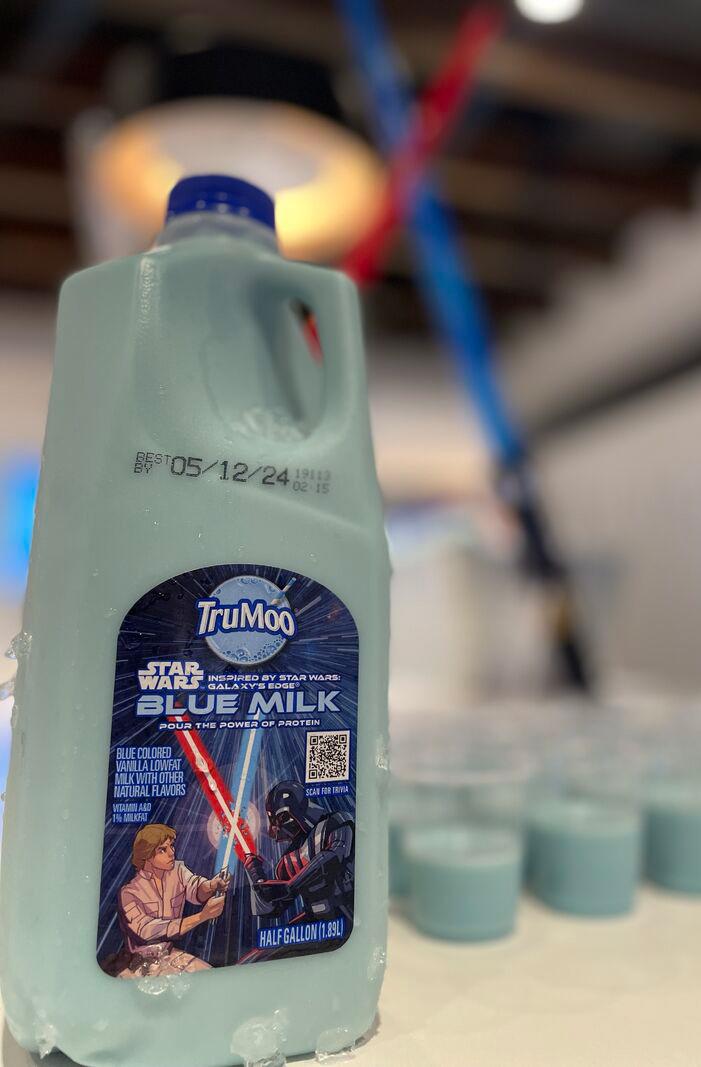

Last month, the company was honored at the PartnerNetwork Conference, held at the Hyatt Regency in Orlando, Florida, with the 2024 OEM Innovation Award for its Hygienic Robotic Packaging System.
Horia Saulean, the director of robotics solutions at DCC Automation, accepted the award on DCC Automation’s behalf.
Horia’s leadership and his team’s expertise are pivotal to the success of the Hygienic System. The synergy of their skill, dedication, and commitment to setting high standards epitomizes the company’s continuous strive for excellence. With a firm eye on the horizons of the manufacturing industry, DCC Automation’s culture and ambition lead the charge in the pursuit of advanced digital transformation.
Galactic energy pulsed through DFA headquarters in Kansas City, Kan. yesterday during our #StarWarsDay celebration!
We ventured into a galaxy far, far away with our very own tasting of the new STAR WARS™ TruMoo® Blue Milk.
The photos capture denizens from all sectors at HQ enjoying this stellar treat.
Raise a glass of Blue Milk and share your own #StarWarsDay celebration photos with us.


Last month, leaders across our company joined together for our 2024 Leadership Conference, united by our Limitless mindset. Guided by our Purpose of Packaging a Better Future and our Key Strategic Initiatives, we unlocked new ways to learn, lead, and grow. Thank you to all attendees and presenters for contributing to the success of this event.